The History of the Birthplace
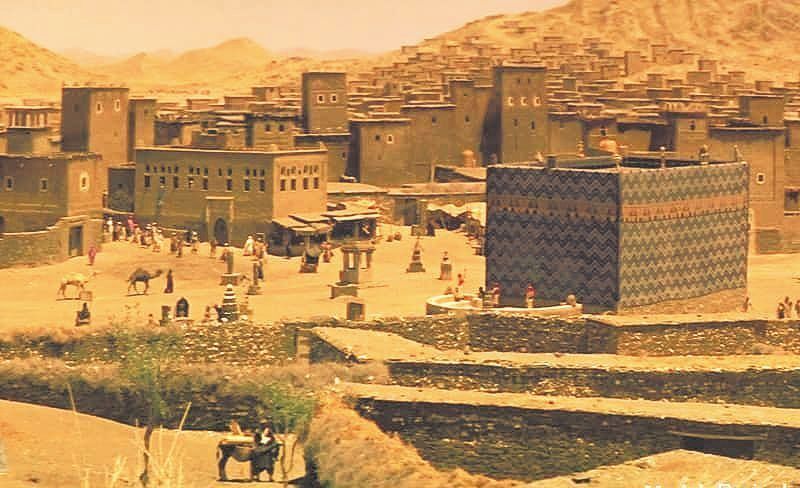
Evidence of Preservation
The history of the bp site shows that it has been the policy of successive leaders of the Islamic world to deliberately preserve the bp. In this chapter, we present evidence of this preservation through an evaluation of the four factors that would have determined whether the bp site was protected, and, if so, how this was likely to be carried out:
--1. Possession of the bp site: Who owned the site, and who was not permitted to. [elaborate ]
--2. The preservation works - A chronology of the major events, renovations, and constructions that affected/related to the bp
site.
--3. Whose agreement was required to carry out these works?
--4. Reasons to preserve the bp
--5. Who could have opposed the preservation, but didn‟t?
1. Possession of the BP site:
Who owned the site - and who was not permitted to.
During its 1400 year history, the bp site has remained in the possession of either the Prophet saw, the Prophet‘s saw relatives, state authorities, or persons of high repute who had demonstrated their suitability to curate the bp site, by having previously been assigned to positions of trust, and leadership of Muslim territories, by the state:
Owner Period Prophet saw 570-571 to 622 AD / 53-52 BH-, ###check Prophet‟s saw Cousin: Aqil bin Abi Talib and Abi Talib‘s sons 622 AD - between 670AD and 680AD Prophet‟s saw birthplcae adjacent neighbour - Governor of Yemen: Muhammad bin Yusuf al-Thaqafi, and his household . Between 670AD and 680AD to 788AD /171AH State - Al-Khayzuran bint Atta (Queenmother) 788AD /171AH to 1951 Former Mayor of Mecca: Shaykh Abbas bin Yusuf al-Kattan 1951 to ???? State - Ministry of Hajj and Endowments c.???? to Present look at signage when put on
History of the ownership of the BP site
The bp site was continually in the care of parties who had demonstrated a concern for the promulgation of the Islamic faith or the welfare of its peoples and lands. Each had a vested interest in preserving the bp site: either to honour the memory of the Prophet saw and his mission, or to maintain the sacred character of Mecca - the spiritual centre of the Islamic world and the destination for millions of pilgrims.
We know from the expansion history of the gm, that the bp site has never had a ,material change of use or been redeveloped for any other purpose, be it residential, commercial, or state use - until it came under wahhabi control ???ot was used as the offices of the ministry of haj. The plots adjacent to the bp site, and throughout the central Mecca area, have been repeatedly developed over the centuries. The bp site‗s proximity to the gm, has meant that it has been considered prime real estate since the 1st century of Islam. Yet, it was never made available to developers for exploitation. Rather, its treatment has mirrored that of the gm, preservation and embellishment. This did not occur by happenstance, rather it appears to be the result of a long-standing consensus which viewed the bp site as of such high religious significance, that it deserved to be preserved, and often with the direct involvement of the caliph/king himself
2. The preservation works
The chronology of major events, renovations, and constructions that affected the bp site:
1. Prophet‟s saw Father 560 AD
1. The Prophet (pbuh) was born in the home of his father `Abdullah ibn `Abdul-Muttalib. The house previously belonged to the Prophet‘s saw grandfather, Abdul-Muttalib (also known as Shaybah ibn Hashim), and who was Chief of the Banu Hashim Clan (d. 578). After becoming blind, Abdul-Muttalib fn1 decided to divide his wealth amongst his children during his lifetime, by granting each of them a share as a gift. This allowed each child to take possession of his/her share before their father‘s death. The birthplace of the Prophet (pbuh), together with the land surrounding the house, was granted to the Prophet‘s saw father Abdullah ibn Abdul Muttalib.
Fn1 [old and blind]. The Hadj: An American's Pilgrimage to Mecca By Michael Wolfe 2013
--
https://muhammadencyclopedia.com/article/en/birthplace-of-prophet-muhammad#content-foot-40
Transfer of Ownership of the Holy Prophet’s Birthplace
The house in which Prophet Muhammad was born, originally belonged to Abdul Muttalib, who was the paternal grandfather of the Holy Prophet . The house was given to Abdullah40 and later on, it was given to Prophet Muhammad .
fn40: Nasir ibn Ali Al-Harithi (2009), Al-Aathar Al-Islamiyah fe Makkah Al-Mukarramah, Maktabah Al-Malik Fahad, Riyadh, Saudi Arabia, Pg. 349-350.
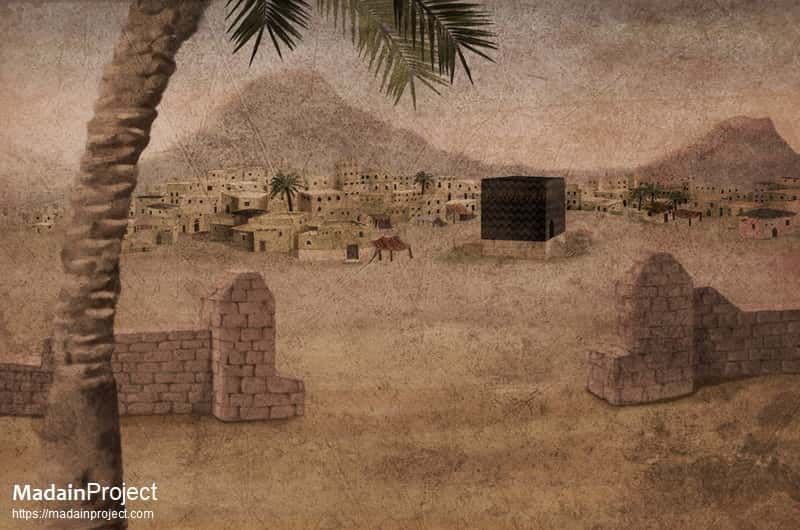
2. Prophet saw 570-571 AD / 53-52 BH,
Possession of the birthplace house passed to the Prophet saw after the demise of his parents: his father Abdullah ibn Abdul Muttalib in 570-571 AD / 53-52 BH, and his mother Aminah bint Wahb 577 CE / 46 BH. The house remained in the ownership of the Prophet saw until 622AD, when he was forced to leave Mecca to escape persecution. The Prophet saw and his family migrated to Madinah.
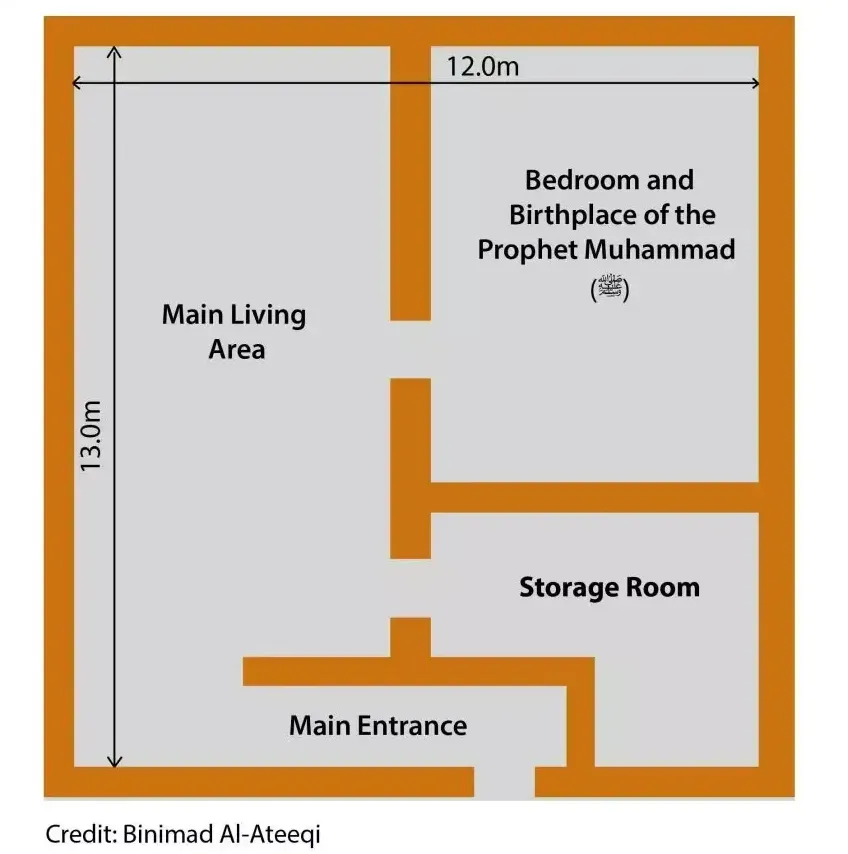
3. Aqil bin Abi Talib - Prophet's saw Cousin 622 AD
In the Prophet‘s saw absence, responsibility for the bp house and its contents was passed to the Prophet‘s saw relatives. Aqil bin Abi Talib - the first cousin of the Prophet saw - fn2 was given possession of the house, and the responsibility of safekeeping it.. The Prophet saw is believed to have returned and lived in the house again in 632AD, the year of the Farewell Speech fn1. During his management of the bp site, Aqil bin Abi Talib would neither develop nor sell the house.
Fn2 aquil ownership ---*Shaykh Abu Bakr bin „Ali bin Tahirah
Shaykh Abu Bakr bin ‗Ali bin Tahirah in his book, al-Jam‘i al-Latif fi Fall Makkah wa Ahliha wa Bana’ al-Bait ash-Sharif: Aqil bin Abi Talib died in 670AD. Aqil had 4 sons: Muslim ibn Aqil, Jafar ibn Aqil, Muhammad ibn Aqil, and Abd al-Rahman ibn Aqil. Muslim ibn Aqil died in September 680 AD in Kufa, while his three brothers were killed in the Battle of Karbala in October 680AD. Therefore, the transfer the bp house to Muhammad bin Yusuf al-Thaqafi by one of Aqil‘s sons (after Aqil‘s death) must have occurred between 670AD - 680AD.
Fn1 live again farewell speech *Abi al-Walid Muhammad bin Abdullah bin Ahmad al-Azraqi (d.223H/837CE) The Shaykh of the Makkan historians, Abi al-Walid Muhammad bin Abdullah bin Ahmad al-Azraqi in his Book: Akhbar Makkah Wa Ma Ja‘a Fiha Min al-Athar In the course of discussing the historical places in Makkah he said (2/199),
--
https://muhammadencyclopedia.com/article/en/birthplace-of-prophet-muhammad#content-foot-40
When the Holy Prophet migrated to Madinah, this house came in the possession of Aqeel ibn Abi Talib. 41 The same is endorsed by Sheikh Muhaddith Abdullah Ghazi, 42 Imam Diyar Bakri 43 and many others.
ft: 41: Izz Al-Din Ali ibn Muhammad Al-Shaibani ibn Athir (1997), Al-Kamil fe Al-Tareekh, Dar Al-Kitab Al-Arabi, Beirut, Lebanon, Vol. 1, Pg. 416.
ft42: Shaikh Muhadith Abdullah Al-Ghazi Al-Makki (2009), Ifadat Al-Anam be Zikr Akhbar Baladillah Al-Haram, Maktaba Al-Asadi, Makkah, Saudi Arabia, Vol. 2, Pg. 68.
ft43: Hussain ibn Muhammad ibn Al-Hasan Al-Diyar Bikri (2009), Tareekh Al-Khamees fe-Ahwal Anfus Al-Nafees, Dar Al-Kutub Al-Ilmiyah, Beirut, Lebanon, Vol. 1, Pg. 364.
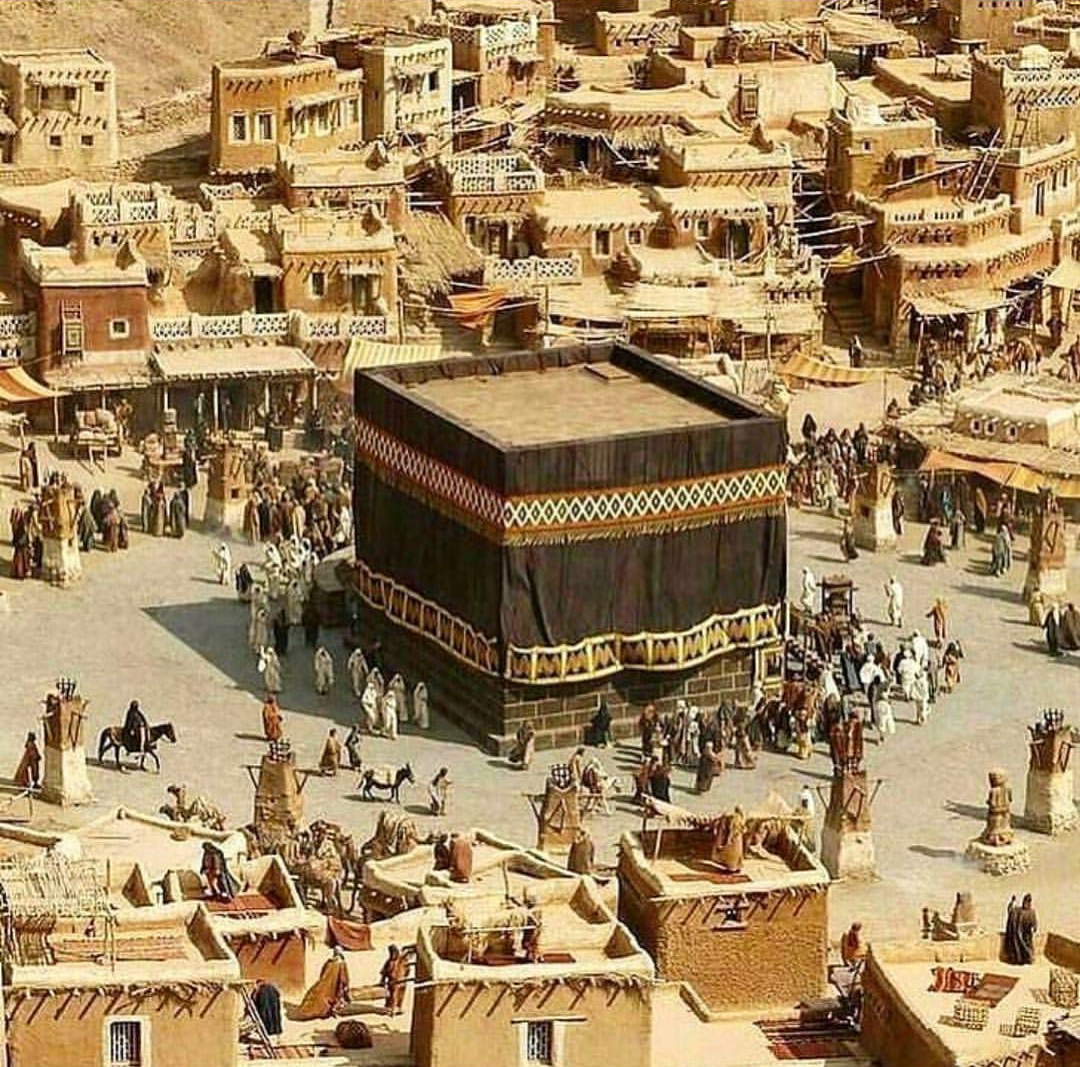
https://muhammadencyclopedia.com/article/en/transformation-of-the-mawlid-of-prophet-muhammad
Transformation of the Mawlid of Prophet Muhammad
(Mufti. Shah Rafi Uddin Hamdani & Dr. Imran Khan)
During the reign of the four righteous caliphs or Khilafat-e-Rashida i.e. Abu Bakr , Umar , Uthman and Ali , the Mawlid remained in its primary condition. No construction or renovation took place in the reign of Umayyads as well. 1 [[FT1]] Nothing changed in the early period of Abbasid Caliphate.
FT1: Ali Shabbir (1930), Tareekh Maulid Al-Nabi, Deccan Law Report, Deccan, India, Pg.14-15.
https://muhammadencyclopedia.com/article/en/transformation-of-the-mawlid-of-prophet-muhammad
4. Muhammad bin Yusuf al-Thaqafi - Prophet‟s saw birthplace‟s neighbour 670-680AD
After Aqil bin Abi Talib‘s demise in 670AD, his sons - Muslim ibn Aqil, Jafar ibn Aqil, Muhammad ibn Aqil, and Abd al-Rahman ibn Aqil - continued the role of curator. In the period between 670AD and 680AD, the sons agreed to let the Prophet‘s saw adjoining neighbour, Muhammad bin Yusuf al-Thaqafi, acquire the bp site fn3. Al-Thaqafi served as the deputy governor for Fars (Iran) and later served as governor for Yemen; his brother was al-Hajjaj ibn Yusuf, the powerful governor of Medina and then governor of Iraq. Al-Thaqafi, who lived in a substantial property next to the Prophet saw house, kept the bp house preserved and intact, and the site became known locally as 'al-Bayda‘ - the Luminous fn4.
It is noteworthy that Aqil‘s sons only relinquished control of the bp [[shortly before all 4 were killed in various conflicts in 680AD. Furthermore,]] the house was specifically given to someone who was not only known to them, being a close neighbour, but also a person who could be considered capable - due to his wealth and position of power - of preserving the bp and shielding it from exploitation.
Fn3sold to my
*Shaykh Abu Bakr bin „Ali bin Tahirah
Shaykh Abu Bakr bin ‗Ali bin Tahirah in his book, al-Jam‘i al-Latif fi Fall Makkah wa Ahliha wa Bana’ al-Bait ash-Sharif:
F4luminous
Shaykh Abu Bakr bin „Ali bin Tahirah
Shaykh Abu Bakr bin ‗Ali bin Tahirah in his book, al-Jam‘i al-Latif fi Fall Makkah wa Ahliha wa Bana’ al-Bait ash-Sharif:
--
https://muhammadencyclopedia.com/article/en/birthplace-of-prophet-muhammad#content-foot-43
Aqeel ibn Abi Talib then sold this house to Muhammad ibn Yousuf (Brother of Hajjaj ibn Yousuf). 44 Muhammad ibn Yousuf purchased this house in one hundred thousand Dinars and added it into his house and called it ‘Al Baida’ (white building), it was also called the House of ibn Yousuf. 45
References
ft 44: Muhammad ibn Abdullah Al-Azraqi (2012), Akhbar Makkah wa ma Ja’a feha min Al-Aathar, Maktabah Al-Asadi, Makkah, Saudi Arabia, Vol. 2, Pg. 811.
ft45: Hussain ibn Muhammad ibn Al-Hasan Al-Diyar Bikri (2009), Tareekh Al-Khamees fe-Ahwal Anfus Al-Nafees, Dar Al-Kutub Al-Ilmiyah, Beirut, Lebanon, Vol. 1, Pg. 364.
5. Al-Khayzuran bint Atta 788AD /171AH
Al-Khayzuran bint Atta, the wife of the Caliph Al-Mahdi and mother of both Caliphs Musa al-Hadi and Harun al-Rashid, ordered that the bp site to be brought into the public domain. She compulsorily purchased the whole site from al-Thaqafi‘s family and separated al-Thaqafi‘s plot from the bp. Al-Khayzuran also introduced preservation measures for the protection of the bp site by consecrating the birthplace into a mosque fn5. This allowed, and gave two reasons for, the public to visit the birthplace: (i) to perform the ritual prayers; (ii) to come to know, and pay homage to, the sacred site. Al-Thaqafi, and his family‘s, safeguarding efforts were successful in maintaining the structural integrity of the bp site, so that even by the time of Al-Khayzuran‘s arrival, more than a hundred and fifty years after the Prophet saw left the house, it could still be recognised, and appreciated, by the wider Muslim world.
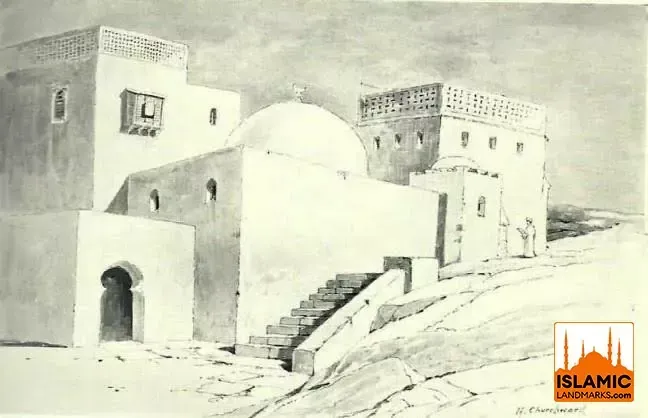
Interestingly, Al-Khayzuran also obtained 'the House of Islam', the property where the Prophet saw and his Companions would meet in the earliest days of Islam. While historically, the bp house is renowned for being the birth site of the Prophet saw and his first place of residence, the House of Islam is recognised as one of the first places where the Prophet saw and his followers practiced their faith and prayed. However, perhaps in recognition of the significance of a prophetic birthplace, Al-Khayzuran decided to use the houses in contrary fashion and chose to preserve the bp house and sanctify it further by converting it into a house of prayer, while turning the House of Islam into a private residence for her stays in Mecca. Despite the fact that she could have stayed in the finest mansions in Mecca, or indeed have had a new palace built in the city, she chose, instead, to live in this small, antiquated house.
[[[; it may be that in Mecca, Al-Khayzuran was not seeking more of the grandeur that she was accustomed to, but the blessings [in this life], and the rewards in the afterlife, which were believed to be bestowed on the custodians and preservers of relics, birthplaces and abodes belonging to the prophets ams of God.fn7 ]]] MAY RAISE WAHAHBI OBJECTION.]]
[[….Interestingly, as with the transfer organised by Aqil‘s sons, the handover of the bp site arranged by Al-Khayzuran from Al-Thaqafi‘s household to state ownership (which also meant Al-Khayzuran‗s ownership/control????), was also carried out shortly before her death in 789 AD / 173 AH.]]
[[Early Makkan historian, al-AzraqI (d.223) mentions the house of the mawlid as among the blessed places in Makkah "where it is desirable to pray." He also mentions that the house was among the most well-known sites amongst the people of Makkah and had been turned into a mosque by the pious mother of the Caliph Harlin aI-RashId. He also reports that Mu'awiyah, the Umayyad Caliph and Companion of the Prophet, had turned the house in which the Prophet used to live and in which his children were born, into a mosque, to honor it. fn120>>> Fn120: Al-AzraqI,Akhbar Makkah, Vol.2,pp.l98-l99. ]]
Fn5mosque---
*Abi Abdullah Muhammad bin Ishaq al-Fakihi (245H/859CE)
Abi Abdullah Muhammad bin Ishaq al-Fakihi in his book: Akhbar Makkah fi Qadim al-Dahr wa Hadithuhu…
Fn6. Muhammad Tahir al-Kurdi al-Makki - 2004
Muhammad Tahir al-Kurdi al-Makki said in his book On the history of Makkah and the Blessed House of God:??????
Fn7 F. E. Peters Mecca: A Literary History of the Muslim Holy Land p117 Princeton University Press, 2017
######################
https://muhammadencyclopedia.com/article/en/transformation-of-the-mawlid-of-prophet-muhammad#content-foot-11
EXTRA ADDED 31/5/25 TO BE SORTED
However, in 171 A.H., Queen Khezran, who was the mother of Haroon Al-Rashid (Reigned:170-193 A.H.), and a very pious woman, came to Makkah. There, she paid a tribute to the house of Prophet Muhammad . 2 [[FT2]] Queen Khezran purchased that portion of the house of Ibn Yusuf, where the Holy Prophet was born and built a mosque there, 3 [[FT3]] so that prayers were offered in it. 4 [[FT4]] This has been endorsed by Ibn Athir 5 [[FT5]] and Sarhan Masood ibn Muhammad Al-Fasi as well. The mosque was constructed in such a manner that its door opened in the alley of the Mawlid. 6 [[FT6]] The mosque built on it was named ‘Dar Al-Mawlid’. From that date till now, this place is known by this name. 7 [[FT7]] This mosque was also called ‘Mosque Madqaq’. 8 [[FT8]] Later on, this mosque was reconstructed by the wife of Haroon Al-Rashid.
FT1: Ali Shabbir (1930), Tareekh Maulid Al-Nabi, Deccan Law Report, Deccan, India, Pg.14-15.
FT2: Ibid., Pg.16-17.
FT3: Abu Al-Faraj Ali ibn Ibrahim Halabi (1427 A.H), Insan Al-Uyun fi Seerat Al-Amin Al-Mamun, Dar Al-Kutub Al-Ilmiyah, Beirut, Lebanon, Vol. 1, Pg. 92.
FT4: Muhammad ibn Muhammad ibn Zahira Al-Makhzumi (2003), Al-Jam’a Al-Latif fe Fadl-e-Makkah wa Ahliha wa Bina Al-Bait Al-Sharif, Maktabah Al-Thaqafat Al-Diniyah, Cairo, Egypt, Pg. 285.
FT5: Izz Al-Din Ali ibn Muhammad Al-Shaibani ibn Athir (1997), Al-Kamil fe Al-Tareekh, Dar Al-Kitab Al-Arabi, Beirut, Lebanon, Vol. 1, Pg. 416.
FT6: Abu Sarhan Masood ibn Muhammad Al-Faasi (2010), Nafaiys Al-Darar min Akhbar Sayed Al-Bashar, Markaz Al-Dra’sat wal Abha’th wa Ihya Al-Turath, Rabat, Morocco, Vol. 1, Pg. 108.
FT7: Abdullah Muhammad Abkar (2004), Suwar min Turath Makkah Al-Mukkaramah, Muassasah Uloom Al-Quran, Beirut, Lebanon, Pg. 39.
FT8: Muhammad Abd Al-Rauf Al-Manawi (2004), Al-Ujalat Al-Saniyyah Ala Alfiyah Al-Seerat Al-Nabawiyah, Dar Al-Kutub Al-Ilmiyah, Beirut, Lebanon, Pg. 28.
######################
https://www.islamveihsan.com/peygamberimizin-savdogdugu-ev.html
Hayzuran, the wife of Mahdi Billah, one of the Abbasid caliphs , had the house where the Prophet Muhammad (peace be upon him) was born repaired and converted into a mosque. Inside this mosque, which has two domes, the area accepted as the birthplace of the Prophet Muhammad (peace be upon him) was designated by enclosing it in a red-covered hut. During the repairs made in 1296, this area was enclosed in a cage and covered with a green satin cloth, and the domes were decorated inside and outside.
6. Al-Nasir li-Din Allah 1180-1181AD / 576AH
Al-Nasir was the 34th Abbasid Caliph in Baghdad and ruled from 1180 – 1225. He carried out a renovation of the bp site in 576 (H.E.) [[1180-1181]]fn1. His term as Caliph is marked by attempts to restore the Caliphate to its ancient dominant role by trying to achieve a rapprochement of the different opposite dogmatic trends in Islam, and a policy of friendships or alliances with the Shia, the Zaydi Imams of Yemen, the Ayyubids of Egypt, and with Qatadah ibn Idris, the Sharif of Mecca..
Fn1: Taqi ad-Din al-Fasi (775-832 H.E.) Shifa al-Gharam bi-Akhbari al-Balad al-haram,
Fn2: Bibliotheca Orientalis XXXIV No 1 / 2 , Januari-Maart 1077 p108
Fn2/3 Taqi al-Din Muhammad ibn Ahmad al-Fasi
One of the most renowned historians of early and medieval Mecca was Taqi al-Din Muhammad ibn Ahmad al-Fasi (775-832 A.H. /1373-1429 A.C.). He was not only a Maliki qadi (judge) in Mecca, but also a scholar, hafiz, and faqih. He is best known for his works on the history of Mecca, its rulers and notable natives. Of his 16 books on Meccan and Islamic history, two of the most celebrated are: Shifa' al-Garam bi Akhbar al-Balad al-Haram, a comprehensive history of Mecca, and al-'Iqd al-Thamin fi Tarikh al-Balad al-Amin, a collation of the profiles of 3,548 male and female personalities who lived or died in Mecca. In researching his works, al-Fasi was known for going beyond conventional sources and seeking more tangible evidence, such as inscriptions on plaques that recorded the foundation or renewal of buildings or establishments, gravestones, and coinage.
#######################
EXTRA ADDED 30/5/25
https://muhammadencyclopedia.com/article/en/transformation-of-the-mawlid-of-prophet-muhammad#content-foot-8
Construction by the Kings of Egypt and Yemen
After Queen Khezran, the construction and expansion of the birthplace of the Holy Prophet was done by the Egyptians and the Yemenites. Sheikh Taqi Al-Din Al-Fasi states:
Much of the history of its (mawlid's) construction has remained unknown to us. What I have learned about it is that Al-Nasir of the Abbasids built it (mawlid) in the year 576 AH. Then, King Al-Muzaffar of Yemen worked on it in the year 666 AH. After that, his grandson Al-Mujahid contributed to it (mawlid) in the year 740 AH, and in the year 758 AH, it was further developed by Prince Shaykhun, one of the high-ranking officials of the state in Egypt. Then it (mawlid) was built in 766 A.H. by the Egyptian governor, Yalbagha Al-Khaski, in the reign of Shah Al-Ashraf Shaban of Egypt Sultanate. At the end of or after 801 A.H., King of Egypt, Al-Zahir Barqoq constructed the birthplace of the Holy Prophet on the budget that he had allocated to spend on the construction of Masjid Al-Haram and other things in Makkah. The construction of the Mawlid was done after his death. FT9
FT9: Muhammad ibn Ahmed Taqi Al-Din Al-Faasi (2000), Shifa Al-Gharam be Akhbar Al-Balad Al-Haram, Dar Al-Kutub Al-Ilmiyah, Beirut, Lebanon, Vol. 1, Pg. 357-358.
Ali ibn Abd Al Qadir Al-Tabri also endorsed this fact. 10 [[FT10]] After these developments, Sheikh Ahmad ibn Muhammad Makki states that the Mawlid was built by some other people as well. He states:
"Viceroy of Egypt, Muhammad Ali Pasha is also among the constructors of the birthplace of the Holy Prophet . He constructed it in the decade of 1230 A.H.(between 1220-1230 A.H.), when he was the ruler of Makkah. Similarly, Sultan Abdul Majid Khan is one of the constructors of this place as well." FT11 "MINE
This shows that Mawlid of Prophet Muhammad was constructed and renovated many times in the course of history by various kings and high officials of different Muslim states.
FT10: Shaikh Ali ibn Abd Al-Qadir Al-Tabri (1996), Al-Arj Al-Miski fi Tarikh Al-Makki, Al-Maktaba Al-Tujjariyah, Makkah, Saudi Arabia, Pg. 68-69.
FT11: Shaikh Muhammad ibn Ahmed Al-Maliki Al-Makki (2004), Tahseel Al-Maram fe Akhbar Al-Bait Al-Haram Wal-Mashair Al-Azzam, Maktaba Al-Asadi, Makkah, Saudi Arabia, Vol. 1, Pg. 539.
https://muhammadencyclopedia.com/article/en/transformation-of-the-mawlid-of-prophet-muhammad#content-foot-8
#########################
https://www.aleqt.com/2017/09/22/article_1255506.html
AH, and his grandson Al-Mujahid in 740 AH. It was also rebuilt by Prince Shiukhn in 758 AH, and Sultan Suleiman renovated it in 935 AH. Sultan Muhammad ordered its reconstruction in 1009 AH as well. During this reconstruction, its walls were raised, a great dome and a minaret were built on top of it, and endowments from the Roman lands were endowed to i
7. Sultan Al Malik al-Muzaffar Yusuf 1268 AD / 666AH
Al Malik al-Muzaffar was the King of Yemen (1250–1295 AD / 647–694 AH) and part of the Rasulid dynasty that ruled Yemen from 1229 to 1454. He undertook preservation works on the bp house in 1268AD / 666AH fn1. By 1264, Al Malik al-Muzffar had partial control over Mecca, but faced competition from al-Malik al-Zahir Rukn al-Din Baybars al-Bunduqdari, the Mamluk Sultan of Egypt and Syria:
“The independent ruler of the Yemen, Al Malik al-Muzaffar…. declared his own sovereignty over Mecca by sending and draping the kiswa over the Kaaba, a Caliphal prerogative from the earliest days of the Abbasids. Two years later, Baybars repeated the gesture from Cairo, and thereafter, for nearly twenty years, the rulers of Egypt and the Yemen were locked in a protocol battle for Mecca and the Hajj, in 1268 and 1273 the kiswa was supplied by the Yemen, while in 1269 and 1270 it was sent from Egypt. More, there was a marked increase in the number and substance of the gifts sent by the two Sultans for the notables of the Hijaz, who were, as usual, the prime beneficiaries of such a contest.” fn2
Fn1 Taqi ad-Din al-Fasi (775-832 H.E.) Shifa al-Gharam bi-Akhbari al-Balad al-haram,
Fn2: F.E. Peters, Mecca: A Literary History of the Muslim Holy Land, p 149, Princeton University Press, 14 Mar 2017
Sultan al-Mujahid Ali 1339-1340AD / 740AH
The Rasulid Sultan al-Mujahid Ali reigned 1322–1363. He continued the philanthropic policies of his grandfather, Sultan Al Malik al-Muzaffar Yusuf, who encouraged works of public interest. Al-Mujahid Ali built mosques, monuments, citadels, roads, and water channels throughout the Rasulid domain, as well as a number of projects in Mecca fn1. In 1339-1340 / 740, Al-Mujahid Ali oversaw a refurbishment of the bp site.fn2
Fn1 Josef W. Meri; Jere L. Bacharach (2006). Medieval Islamic Civilization: L-Z, index. Taylor & Francis. p. 669.
Fn2 Taqi ad-Din al-Fasi (775-832 H.E.) Shifa al-Gharam bi-Akhbari al-Balad al-haram,
Shaykhu 1357AD / 758AH
Shaykhu al-Umari an-Nasiri was a high-ranking Mamluk emir during the reigns of Muzaffar Hajji (1346–1347), an-Nasir Hasan (1347–1351, 1355–1361), and as-Salih Salih (1351–1355). During the second reign of an-Nasir Hasan, Shaykhu was promoted to the office of emir kabir (great commander) and had a key role in directing the affairs of the state.fn1 Shaykhu carried out a series of repairs and embellishments of the bp site in 1357AD/ 758 H.E
Fn1: Howyda N. Al-Harithy. "The Complex of Sultan Hasan in Cairo: Reading Between the Lines". In Necipoglu, Gülru. Muqarnas: An Annual on the Visual Culture of the Islamic World, Vol.13, 1996
Fn2 Taqi ad-Din al-Fasi (775-832 H.E.) Shifa al-Gharam bi-Akhbari al-Balad al-haram. AL-Fasi describes Shaykhu - perhaps to reflect his true status within the Mamluk power structure -as: ―"Prince Shaykhun, one of the leaders of the state of Egypt".
King al-Ashraf Sh'aban 1363–1366
Al-Ashraf Zayn ad-Din Abu al-Ma'ali Sha'ban ibn Husayn ibn Muhammad ibn Qalawun, better known as al-Ashraf Sha'ban or Sha'ban II, was a Mamluk sultan. During his reign (1363–1377) numerous celebrated architectural works were commissioned, including. the Salahya minaret (also known as the Tribes Gates minaret) on the northern edge of Masjid al-Aqsa, Jerusalem fn1; the Madrasa Umm al-Sultan Sha'ban in Cairo, Egypt; and the overhaul and restorative works on the bp site in the period between 1363-1366 AD fn4. Al Fasi‘s record of al-Ashraf Sha'ban‘s safeguarding efforts on the bp site, documents that while the works took place during al-Ashraf Sha'ban‘s reign and were attributed to him, such was the leadership structure in al-Ashraf Sha'ban‘s tenure, that the work also required, and received, the consent of Yalbugha al-Khasaki, al-Ashraf Sha'ban‘s powerful vice-regent: “During the sovereignty of the King al-Ashraf Sh„aban, the ruler of Egypt with the authority of a director of the state Yulbagha al-Khasaki”fn2
Al-Ashraf Sha'ban reign was known for his distribution of food and money to Meccans: a large scale effort was carried out to alleviate food shortages and resultant starvation in Mecca in 1365. Caravans were sent to Mecca carrying hundreds of tons of wheat to distribute among the inhabitants to stem increasing emigration from the city. Taxes on Hajj pilgrims were decreased, and the Mamluk emirs of Mecca who depended on the pilgrim tax, were compensated with revenue from iqta in Egypt; 40,000 silver dihams was granted to the governor of Mecca. This decree was inscribed on a stone column in the Masjid al-Haram mosque in Mecca.fn3
Fn1: www.islamiclandmarks.com
Fn2: Taqi ad-Din al-Fasi (775-832 H.E.) Shifa al-Gharam bi-Akhbari al-Balad al-haram,
Fn3: Steenbergen, Jo Van (September 2011). "The Amir Yalbugha al-Khassaki, the Qalawunid Sultanate, and the Cultural Matrix of Mamluk Society: A Reassessment of Mamluk Politics in the 1360s". Journal of the American Oriental Society. American Oriental Society. 131 (3): 423–443.
Fn4: Since al-Ashraf Sha'ban‘s reign began in May 1363, and Yalbugha al-Khasaki died in December 1366, therefore, the date on which the decision was taken to instigate preservation works - if not the actual commencement date of the work itself - must have been between May 1363 and December 1366.
King al-Zhahir al-Barquq - 1399AD / 801AH
Al-Malik Az-Zahir Sayf ad-Din Barquq was the first Sultan of the Mamluk Burji dynasty. and ruled 1382–1389 and 1390–1399). Barquq was of Circassian origin, and was initially acquired as a slave for the household of King Al-Hajji Ibn Al-Ashraf Ibn Sha'ban. fn1 After gaining his freedom in 1363AD, Barquq commenced his ascent to the sultanate. During his second reign, Barquq undertook the restoration or re-building of a number Islamic heritage sites in Mecca, including the bp site. Al-fasi states that the preservation works on the bp site were completed in the months after Barquq‘s death ( d. June 1399AD / 801 HE): “The last part of the year of 801 (H.E) or after it from wealth which the King al-Zhahir al-Barquq dispensed generously for the re-construction al-Masjid al-Haram and other places in Makkah and the erection [of the monument] to the birthplace of the Prophet (pbuh) which took place after his death.”
Fn1: Martin W. Daly, The Cambridge History of Egypt, Volume 1, Cambridge University Press,1998, p. 290
Fn2: Taqi ad-Din al-Fasi (775-832 H.E.) Shifa al-Gharam bi-Akhbari al-Balad al-haram
Sultan Suleyman 1525AD / 931AH
Sultan Suleyman was the longest-reigning Ottoman Sultan, ruling from 1520-1566. He had a refurbishment of the Bp site carried out in 1525AD / 931AH. The work was overseen by Abd al-Karim Yaziji, one of the sultan‘s chief officials.fn1 The renovation was studied and documented by the Meccan jurist, hadith scholar, and chronicler Jar Allah Muhammad Ibn Fahd (d. 1547). In 1543, Ibn Fahd completed his account of the refurbishment and construction projects undertaken in the city by the Ottoman sultans Selim I (r. 1512–20) and his son Süleyman (r. 1520–66). The work, titled Nukhbat bahjat al-zaman bi-imarat Makka li-muluk Bani ‗Uthman (The Best of Joy of the Time for the Construction of Mecca by the Kings of the Ottoman Dynasty), provides a detailed description of the buildings and of Ottoman construction techniques.
Fn1: Jar Allah Muhammad Ibn Fahd, Nukhbat bahjat al-zaman bi-imarat Makka li-muluk Bani Uthman (The Best of Joy of the Time for the Construction of Mecca by the Kings of the Ottoman Dynasty) Pp.126–30 file:///C:/Documents%20and%20Settings/Arif%20Khan/My%20Documents/Downloads/Between_Istanbul _and_Gujarat.pdf
###############
https://muhammadencyclopedia.com/article/en/transformation-of-the-mawlid-of-prophet-muhammad#content-foot-11
The Construction of the Dome on the Birthplace of the Holy Prophet
When the state of Hijaz came under the control of Ottoman Empire in 935 A.H., Sultan Suleiman Khan built a dome on the birthplace of the Holy Prophet . In this regard, Sheikh Ali ibn Abdul Qadir writes:
In 935 A.H., Sultan Suleiman built a dome and a mosque on the birthplace of the Holy Prophet , where prayers are offered.ft1
ft1: Shaikh Ali ibn Abd Al-Qadir Al-Tabri (1996), Al-Arj Al-Miski fi Tarikh Al-Makki, Al-Maktaba Al-Tujjariyah, Makkah, Saudi Arabia, Pg. 69.
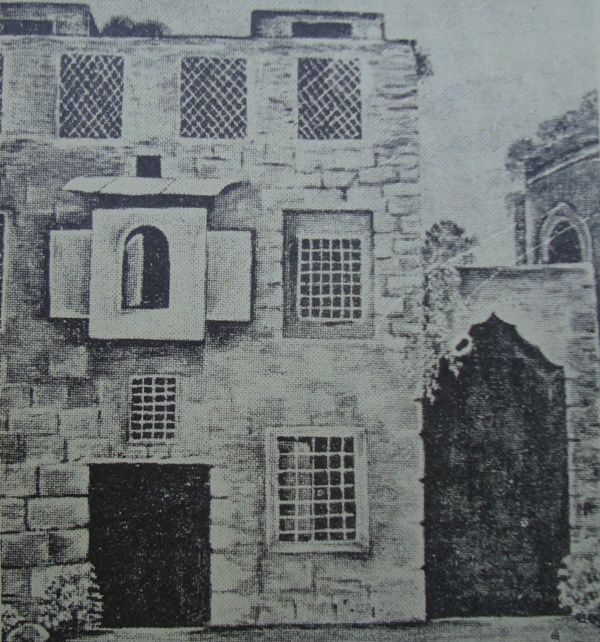
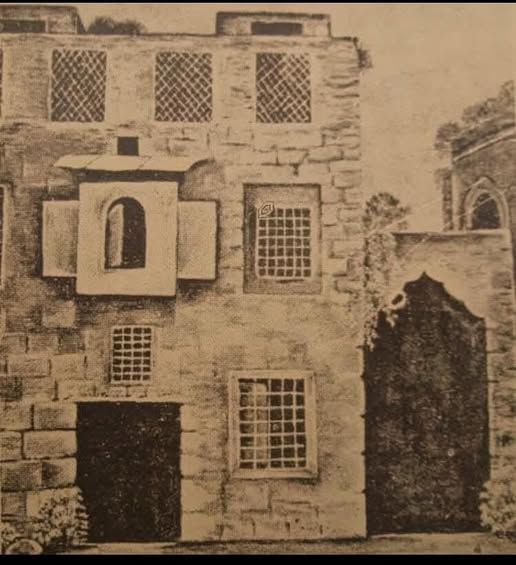
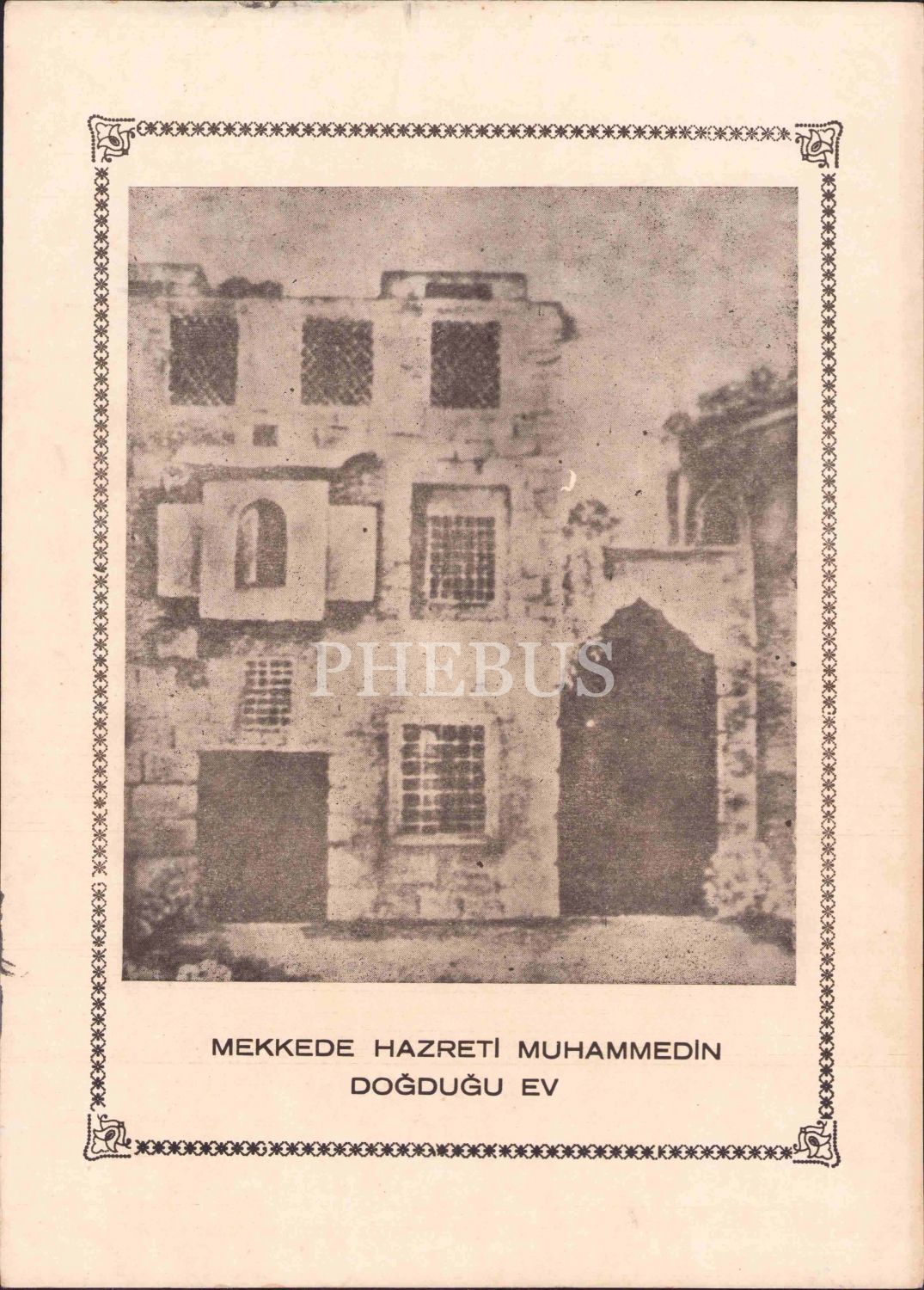
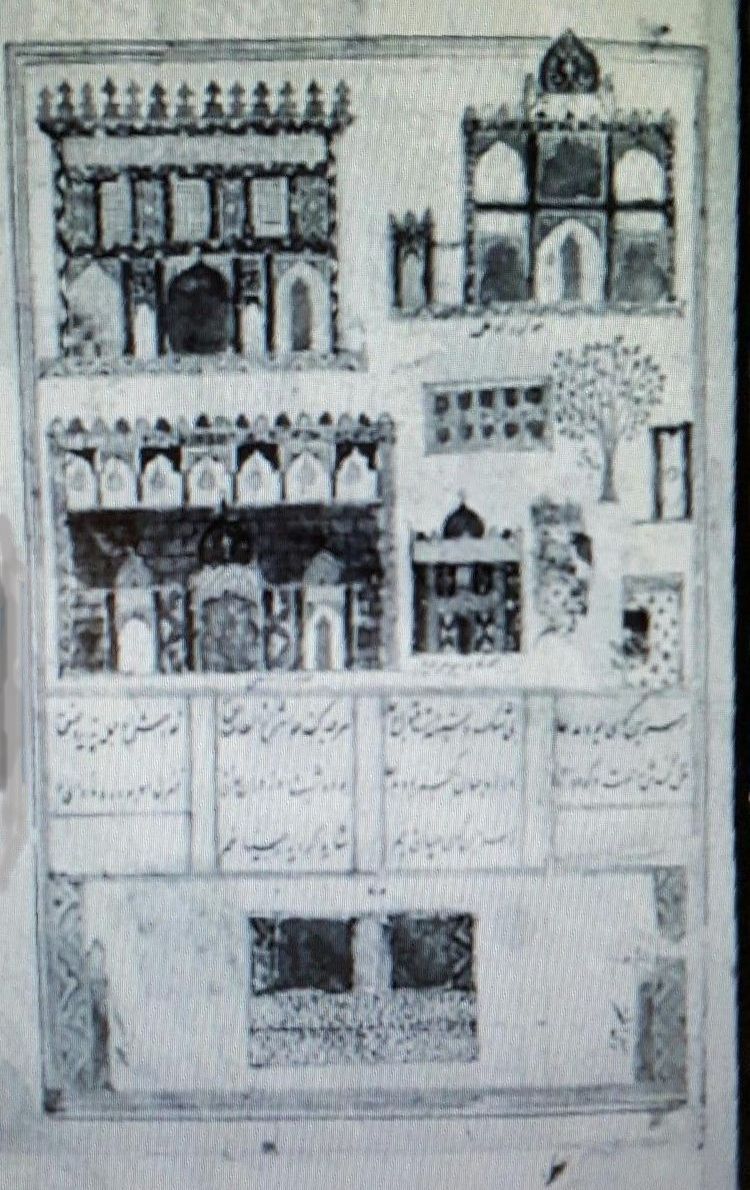
Sultan Suleyman 1556-1557AD / 964AH
PICTURE HERE CRENALLATIONS
Suq al-Layl (night market) - St. Petersburg, State Hermitage Museum
The early image of the building [bp] as a large two-storey dwelling, with crenellations on the roof and trees in the backyard, turned into a domed monument after a reconstruction ordered by Sultan Suleyman in 964/1556-57fn1,fn2
Fn1 Picture and details sourced from: Mamluks and Ottomans: Studies in Honour of Michael Winter, edited by David J Wasserstein, Ami Ayalon, Routledge 2013 p. 174. Searched google books
Fn2: Suq al-Layl (night market) from the St. Petersburg, State Hermitage Museum Inv. no. VR - 491, fol. 20a
Sultan Suleyman had a dome built on top of the bp house in 1556-1557AD / 964AH.(fn7) He also carried out a number of other restorations and new developments in Mecca and Medina during his reign: the Quba Mosque and Masjid al-Qiblatain in Medina were renovated; four madrassas were built for the four schools of Islam: Hanafi, Maliki, Shafii, and Hanbali in Mecca; the Kaaba and Zamzam Well were renovated and a pool was built for the well water. As well as the dome constructed on the bp, the interior ornaments of the other existing domes were also renovated. Later, a dome was also added on top of the Zamam pool by Sultan Mehmed IV.
Fn7: Sabri, Mir’at al-haramayn, vol.5vii, p.1056
AMAZON TITLE: Mir'at al-Haramayn ( Safarnamah-i Makkah ) by Ayub Sabri Pasha
1981, reprint of the 1925 edition. D. 1308 AH., 1890 AD
Pasha was employed in the Ottoman army in Jejaz in c. 1865, and then became an admiral in the Ottoman navy. He is better known for his descriptive books about Mecca, Medina. and the Arabian Peninsula. His five volume work Mir'at al-Haramayn is considered the most comprehensive encyclopaedia in the Ottoman Turkish about the two holy sanctuaries in the hejaz.
####
Ibrahim Rafat Pasha adds that Sultan Suleiman installed the gold chandelier in the Mawlid as well. He states:
In 963 A.H., Sultan Suleiman also gifted three gold chandeliers, one of which was hung in the sacred birthplace and two in Baitullah (the house of Allah), which my father ‘Nammi’ had the honour to hang. ft15
ft15: Ibrahim Rifat Pasha (1344 A.H), Mirat Al-Haramain, Dar Al-Kutub Al-Misriyah, Cairo, Egypt, Vol. 1, Pg. 188.
Sultan Mehmed III 1595-1603
During his reign between 1595-1603, Sultan Mehmed III renovated the minaret at the top of Bab al-Salam in Damascus, as well as adding a minaret to the birthplace house.fn1.This suggests that the bp house was still being used as a mosque in the 16th century - more than eight hundred years after it was first converted to a place of communal prayer. The refurbished bp is depicted in the Uppsala Mecca Painting, which was painted approximately a hundred years after the construction of the minaret was completed, in the early 18th century/1700s.
Fn1:Daily SABAH newspaper 10.11.2017
####
After that, in 1009 A.H., Sultan Muhammad Khan ibn Sultan Murad Khan again ordered the construction of birthplace of the Holy Prophet and a large dome and minaret were raised on it. As Ibrahim Pasha states:
In 1009 A.H., Sultan Muhammad Khan ibn Sultan Murad Khan ordered to construct the building of the (Holy) Prophet's birth place and built a minaret and a great dome over it. ft13
Sheikh Ali ibn Abd Al-Qadir endorses this fact and adds that the expenses were paid from the revenues generated by the Muslim properties in Roman cities. ft14
ft13: Ibrahim Rifat Pasha (1344 A.H.), Mirat Al-Haramain, Dar Al-Kutub Al-Misriyah, Cairo, Egypt, Vol. 1, Pg. 189.
ft14: Shaikh Ali ibn Abd Al-Qadir Al-Tabri (1996), Al-Arj Al-Miski fi Tarikh Al-Makki, Al-Maktaba Al-Tujjariyah, Makkah, Saudi Arabia, Pg. 69.
https://muhammadencyclopedia.com/article/en/transformation-of-the-mawlid-of-prophet-muhammad#content-foot-16
This shows that Muslim rulers of every era expanded or beautified the birth place of the Holy Prophet . Sardar Hussain Pasha and Auliya Chalpi visited the birthplace of the Prophet in 11th century A.H., and Auliya Chalpi has described its scenery and location in one of his travelogues. These travelogues have been recorded by Sheikh Abu Suleiman. He states:
The high dome covered with lead is located inside the Aminah Valley, with a door opening on the north side, (which) descends by ten stairs that go down to the middle of the lower floor. This is a bright dome, as you enter the door, you will find a square Harem. It is under the same dome. There is a door on the inner side, "Bab Aitab Saeedah" which opens to the eastern side. And the Harem is adorned with precious velvet rugs, as if it were a welcoming reception that is 500 feet wide. The mosque is open and beautiful, and the dome is adorned with different colors and imagery, to the extent that it is called a heavenly dome. In the area between the reception to the center of the dome, you will see a new style of pulpit, with a bright dome above it, and the four sides of the dome are adorned with engravings and glasses… It has a pearl enclosed door that is covered with gold. The gifts of the previous pious emperors include the lock and key of the pulpit's gems. There are cushions near this unique pulpit and at the back of the door, on which the servants of the Holy Prophet's saw house sit. Those people also sit here who open the door of this place with a key encrusted with gems, when the pilgrims and visitors arrive... The place, that has honored to receive the Holy Prophet saw from the womb of his pious mother, contains a blessed stone inside the yellow pit, on which marks of the Holy Prophet’s saw body were present. It is a deep pit, in which a man can sit easily. When this blessed area was being excavated, the aroma of flowers and camphor erupted from within; and it is always full of scented water… the servants use pure gold and silver incense burners to spread the fragrance of Musk, Amber, and Oud in such a way that the whole ambience is filled with the beautiful fragrance, which is experienced by all the visitors. On this occasion, our leader Hussain Pasha stood for an hour and he himself burned incense of raw amber so that the whole dome was perfumed with pure and fragrance… This sacred dome is adorned with beautiful chandeliers, new style bulbs and various types of gems. Likewise, it is adorned with beautiful lamps which are all bright and lit all night which light up the entire area. The pillar on the right side of the place has a wooden pulpit, adorned with a unique style and modern carving, this pulpit is small but has a modern design. In the left side of this dome, there is also a small area, and every person wants to offer two Rak'ah prayers in this place… It is also Mustahab (desirable) to pray for one's parents in it. On the four walls of this dome are various carvings of creative calligraphers, and plaques gifted by Prophet Muhammad's saw adorers... Among these paintings are poems praising the Holy Prophet saw and the Kalima Tayyeba. I (Auliya Chalpi), am also included in those who wrote the beautiful and the adored name of Holy Prophet saw in gorgeous form. On the left side of this dome, there are windows on the top, as high as the height of two men, some of the people who are passing by, watch them and pray for good, and others watch these windows curiously as they cross the road, because these windows are located on the main road side. The grand minaret of this mosque still stands, which is one of the earliest monuments, and it is very strong. But, it is not proven that a Friday prayer has been offered in it, because its pulpit is small and Friday prayer is not permissible here. In this blessed city, the establishment of Friday prayers is not permissible in any mosque except Masjid Al-Haram. ft 16
ft16: Abu Sulaiman Abd Al-Wahab Ibrahim (2012), Maktabah Makkah Al-Mukarramah Qadeeman wa Hadithan, Maktabah Al-Malik Fahad Al-Wataniyah, Riyadh, Saudi Arabia, Pg. 65-67.
The plaques mentioned in the above statement also show a glimpse of the building of the birthplace of the Holy Prophet. Thus, Nasir ibn Ali states:
Through this rare depiction, the external features of the building are clarified, showing it situated on a hill and consisting of contiguous architectural blocks. The first block is square in shape, with one of its facades apparently featuring three windows high up on the wall. Its roof is surrounded by a veiled object which is made of colorful bricks called Shabor, in architectural terms. The middle fragment is inclined to the front, covered with a large dome, which ends on a crescent made out of copper, on the outside... another fragment is covered with a dome, that shows the main place of birth (of the Holy Prophet saw). In front of this block and the previous one is a small building covered by a small dome with an arched window on the front facade. You ascend these three architectural blocks by ten steps leading to a rectangular platform, then descend via steps to a corridor that ends by turning left into a passage between the two southern blocks and the Birthplace Building (of Prophet Muhammad saw). The visitor enters the latter building from a door on the left... entering through a gate located to the left of the Birthplace Building (of Prophet Muhammad saw ), which is arched and reflects Moroccan influences. This building is distinguished by a small projecting balcony (roshan) with a mashrabiya on its facade, supported by four wooden posts with a forward-slanting roof to channel rainwater from the Birthplace (of Prophet Muhammad saw ) Building's roof into the alley. This depiction aligns with the description by Evliya Çelebi of the Prophet Muhammad's saw Birthplace when he visited Mecca in the eleventh century Hijri after the reconstruction by Sultan Muhammad Khan, son of Sultan Murad Khan of the Ottoman Empire. ft17
ft17: Nasir ibn Ali Al-Harithi (2009), Al-A’thar Al-Islamiyah fi Makkah Al-Mukarramah, Maktabah Al-Malik Fahad, Riyadh, Saudi Arabia, Pg. 353-354.
The above-mentioned condition of the Holy Prophet’s birthplace dates to the beginning of the ninth decade of the 11th century A.H., in which the renovation was done in an innovative style and elegance, and the glimpse of the building of the birthplace of the Holy Prophet was displayed in a plaque. However, at that time, no one had the idea of giving the birthplace of the Holy Prophet an educational status. This status was given later on when a ruler of the Ottoman Empire started an educational institution there.
The Madrassah
After constructing the mosque, Sultan Suleiman appointed a Mu'aazin (a person who gives adhaan), Imam (the one who leads the prayer), and servants, whose salary came from the waqf (dedicated) properties of the Muslim state in Rome. After that, the Ottoman Empire decided to give the birthplace of the Holy Prophet an educational position. After Sultan Suleiman, the Ottoman Empire established a Madrassa (an educational institution) here, which educated the children (free of cost) and its expenses were also provided by the government. 18 Sheikh Ali ibn Abdul Qadir 19 also endorsed this fact. In this way, the Ottoman Empire is credited for introducing the birthplace of the Holy Prophet to the people as an educational institution, and managed all of its educational expenses.
ft18: Ibrahim Rifat Pasha (1344 A.H.), Mirat Al-Haramain, Dar Al-Kutub Al-Misriyah, Cairo, Egypt, Vol. 1, Pg. 189.
ft19: Shaikh Ali ibn Abd Al-Qadir Al-Tabri (1996), Al-Arj Al-Miski fi Tarikh Al-Makki, Al-Maktaba Al-Tujjariyah, Makkah, Saudi Arabia, Pg. 69.
https://muhammadencyclopedia.com/article/en/transformation-of-the-mawlid-of-prophet-muhammad#content-foot-16
New Paragraph
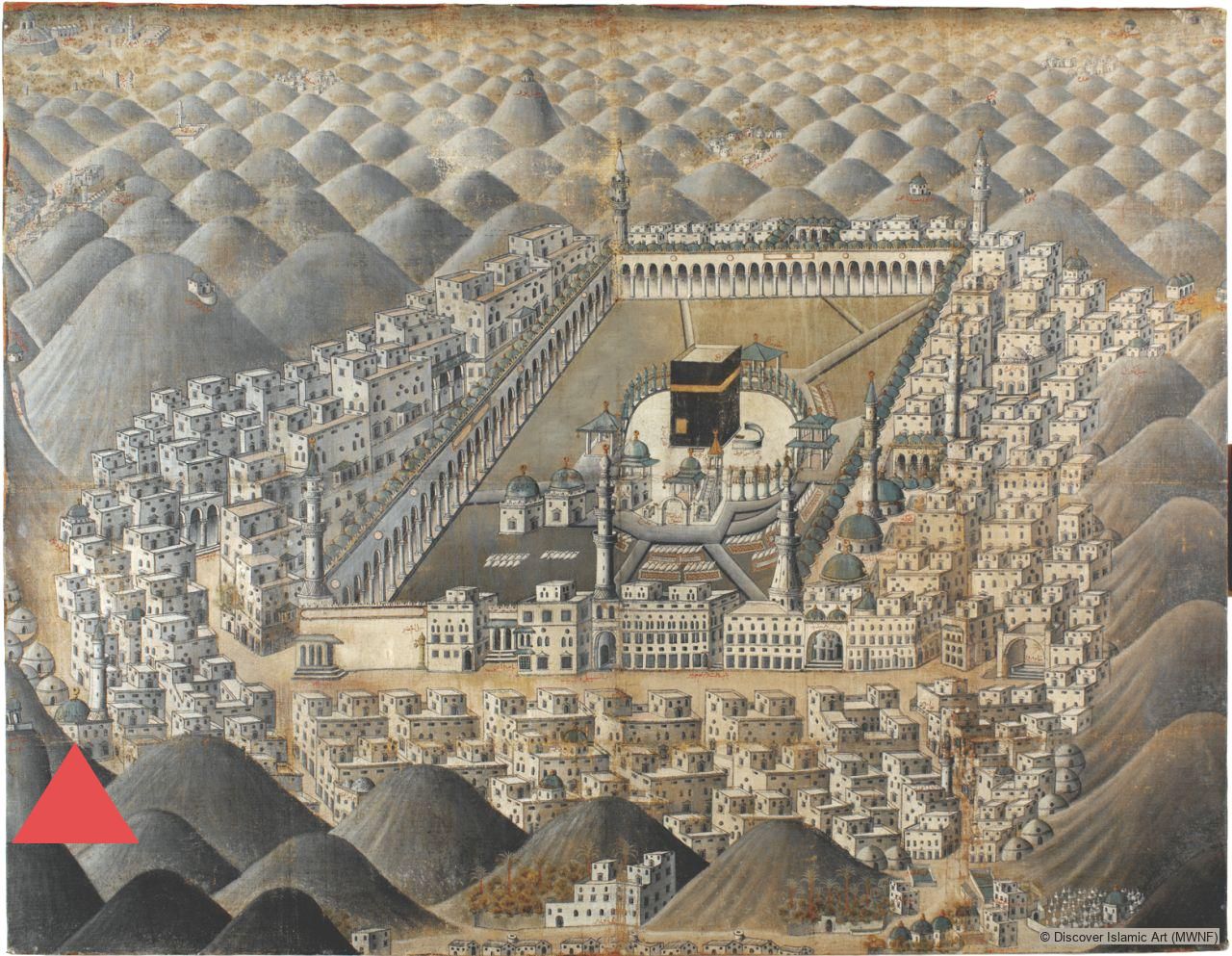
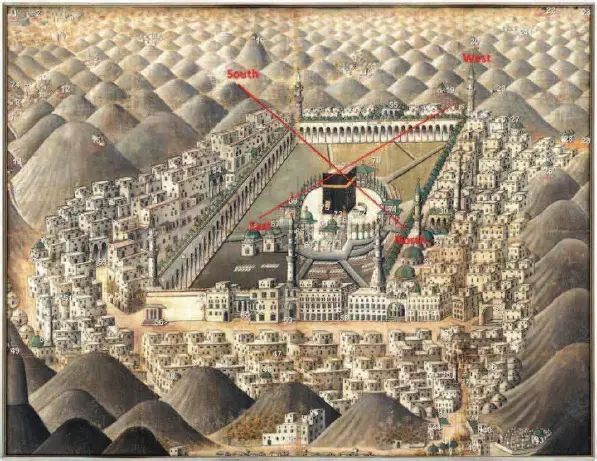
The painting captures a topographical view of Mecca after the Ottoman rebuilding period of the AH 10th century / AD 16th [[sixteenth century]]. The painter has [t. depicted] tried to show the town planning and street patterns, and the sheer density of the old Meccan districts.The GM is in the centre surrounded by the houses of the city and the hills of the Meccan neighbourhood. (fn1)
In the painting, important buildings and places are identified by small labels in red ink (legends), which give information about their name and function. There are 75 of these captions in the painting, which are marked with numerals,
The painting was acquired by the theologian and orientalist Michael Eneman (1676–1714), in Turkey, where he was sent by the Swedish King Charles XII (1682–1718) as his envoy in 1709. The painting was purchased by Uppsala University Library in 1717.
The birthplace of the Prophet saw, [t. which is marked as a] in it's then form of a mosque with a cupola [dome] and a minaret, is in the lower corner to the left of the sanctuary, and indicated with the the author's red triangle mark..
FN 1. Friederike Voigt "Painting" in Discover Islamic Art, Museum With No Frontiers, 2019. http://islamicart.museumwnf.org/database_item.php?id=object;ISL;se;Mus01_A;37;en
Prepared by: Friederike Voigt
DELETE: GOT THE ABOVE PHOTO FROM:
First from: https://i.pinimg.com/originals/98/1d/10/981d10bd82bf9e9a9d567dc8696833bf.jpg
file:///C:/Users/Adamm/Downloads/A_Birds_eye_View_of_Mecca_The_Uppsala_Un.pdf
The rendering/depiction of the bp site in the painting is remarkably accurate, as demonstrated by a photograph of the BP site taken almost three hundred years later - at the beginning of the twentieth century.
This photograph is believed to have been taken between 1901-1910 and was provided by Dr. Meraj Nawab Mirza from The Center of Makkah History at Umm al Qura University in Mecca. (fn1)
Photography Since the 1880s, the city of Mecca has been photographed and filmed.May not need this line.
fn1. Courtesy: Mehmet Tutuncu https://www.academia.edu/37204629/The_Uppsala_Mecca_Painting_A_New_Source_for_the_Cultural_T opography_and_Historiography_for_Mecca
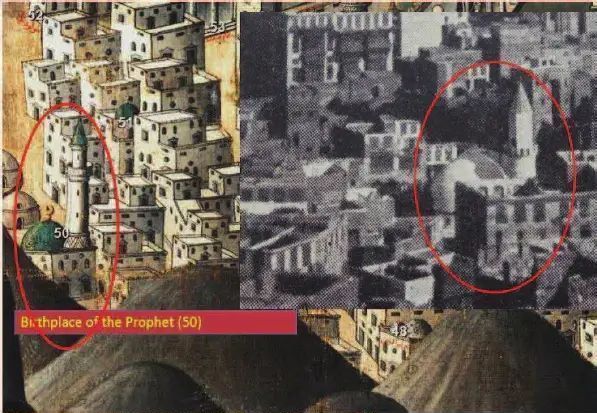
Sultan Mahmud II 1816
Sultan Mahmud reigned 1808 - 1839. He had repairs to the bp site undertaken in1816. In 1802, a military conflict began between the caliphate and Abdul Aziz Ibn Muhammad Ibn Saud. Ibn Saud‘s forces subsequently conquered parts of central Arabia including Mecca in 1803 and Medina in 1804. In accordance with the doctrine espoused by Muhammad ibn Abd al-Wahhab, Ibn Saud‘s forces began dismantling, in part or whole, many historic sites in Mecca in 1806. In the case of the bp site, the dome from above the building was removed. Ibn Saud continued to hold the city until 1812, when the Ottoman army entered Mecca and regained control [[ in 1228]]. After Sultan Mahmud II‘s officials resumed governance of Mecca, the Sultan ordered extensive repair and re-building of damaged sites.
During 1814-15, John Lewis Burckhardt (d. 1817), the Swiss scholar, travelled throughout the western Arabian Peninsula. He is best known for rediscovering the ruins of the ancient Nabataean city of Petra, in Jordan. Burckhardt spent several months studying Mecca, and wrote of his detailed observations of the city and the deportment and culture of the local inhabitants, in his work ‗Travels In Arabia‘fn1. Burckhardt created a map of Mecca, and described in great detail the rites of the Haj, the Ka'bah, the Sacred Mosque, the surrounding heritage sites, and the history of Mecca.
The last year of Burckhardt‘s life was spent editing his journals in Cairo. His account of the Ottoman restoration efforts in Mecca, particularly on the bp site, covers the works carried out up till the end of 1816:
“During the time of the Wahabys, no person dared to visit these places without exposing himself to their hostility; and all the buildings which had been erected on these spots were ruined by them, or their domes were, at least, destroyed…In the autumn of 1816, several artists and workmen, sent from Constantinople, were employed in the Hedjaz to repair all the damage.
[[[“Mouled el Neby, the birth-place of Mohammed, in the quarter named from it. In the time of Fasy a mosque stood near it, called Mesdjed el Mokhtaba. During my stay, workmen were busily employed in re- constructing the building over the Mouled upon its former plan.]]] It consists of a rotunda, the floor of which is about twenty-five feet below the level of the street, with a staircase leading down to it. A small hole is shown in the floor, in which Mohammeds mother sat when she was delivered of him. This is said to have been the house of Abdillah, Mohammeds father…All these Mouleds had undergone complete repair since the retreat of the Wahabys, except that of Mohammed, on which the workmen were still employed.”fn2
MAYBE LEAVE OUT BRACKETS CAUSE SAYS REBUILT
http://www.gutenberg.org/cache/epub/9457/pg9457-images.html
Fn1: Title: Travels In Arabia: An Account Of Those Territories In Hedjaz Which The Mohammedans Regard As Sacred
Author: John Lewis Burckhardt, (London: Henry Colburn, 1829)
Fn2: Page 171
#################
EXTRA:
https://muhammadencyclopedia.com/article/first-demolition-and-re-construction-of-the-birthplace-of-prophet-muhammad
First Demolition and Re-construction of the Birthplace of Prophet Muhammad
In 1218 A.H., during the reign of Saud ibn Abdul Aziz, the people of Najd took over the city of Makkah and demolished the building located on the birth place of the Holy Prophet along with many historical places. When the Ottoman Turks retook the province of Hejaz, they reconstructed the building of Mawlid. This account has been narrated by a renowned European tourist known as J. L. Burckhardt who visited Makkah in 1814 A.D. He wrote the following about the birthplace of the Holy Prophet :
Mouled el Neby, the birth-place of Mohammed (), in the quarter named from it. In the time of Fasy a mosque stood near it, called Mesdjed el Mokhtaba. During my stay, workmen were busily employed in reconstructing the building over the Mouled upon its former plan. It consists of a rotunda, the floor of which is about twenty-five feet below the level of the street, with a staircase leading down to it. A small hole is shown in the floor, in which Mohammed’s () Mother sat when she was delivered of him. This is said to have been the house of Abdullah (), Mohammed’s () father. 1FT1
FT1:John Lewis Burckhardt (1829), Travels in Arabia, The Association of Promoting the Discovery of the Interior of Africa, London, U.K., Vol. 1, Pg. 312-313.
PUT IN DESCRIPTION OF THE BP
A.
https://muhammadencyclopedia.com/article/first-demolition-and-re-construction-of-the-birthplace-of-prophet-muhammad#content-foot-2
The tourists who visited Makkah for pilgrimage have written about the condition of the birthplace of the Holy Prophet in their travelogues which indicate that the Holy Prophet's birthplace was rebuilt in its former shape after its demolition. Muhammad Labeeb states:
"It (birthplace of the Holy Prophet ) is a place elevated about one and a half meters above the road, accessed by stone steps leading to a door that opens to the north. This door leads to a courtyard approximately twelve meters long and six meters wide. In the right (western) wall, there is a door that leads to a dome, in the center of which (leaning towards the western wall) there is a wooden enclosure. Inside this enclosure, there is a marble piece hollowed out to mark the birthplace of Prophet Muhammad . This dome and the adjacent courtyard have a combined area of no more than eighty square meters, and they constitute the house where the Holy Prophet , was born."FT2
FT2: Muhammad Labeeb Al-Batnuni (1329 A.H.), Al-Rihlat Al-Hijaziyah, Matb’a Al-Jamaliyah, Cairo, Egypt, Pg. 52.
B.
https://muhammadencyclopedia.com/article/first-demolition-and-re-construction-of-the-birthplace-of-prophet-muhammad#content-foot-2
Ali Shabbir adds that in the middle of this dome is the place which is considered as the birthplace of the Holy Prophet. At that place, a small frame is erected on which a smaller dome is built. This dome is covered by a green cover, which is embellished with the following verse in golden ink: FT3
FT3: Ali Shabbir (1930), Tareekh Maulid Al-Nabi, Deccan Law Report, Deccan, India, Pg. 22-23.
Surely, a (Glorious) Messenger from amongst yourselves has come to you. Your suffering and distress (becomes) grievously heavy on him (blessings and peace be upon him). (O mankind,) he is ardently desirous of your (betterment and guidance. And) he is most (deeply) clement and merciful to the believers. FT4
FT4: Holy Quran, At-Taubah (The Repentance) 9: 128
The birth place of the Holy Prophet was wrapped in a green cover in a certain way so that the exact locus of Prophet Muhammad's birth could be indicated.
https://muhammadencyclopedia.com/article/first-demolition-and-re-construction-of-the-birthplace-of-prophet-muhammad
Abdülhamid II r.1876-1909
During his reign, Abdülhamid II carried out repairs and embellishments of the gm; renovated the birth place house of the Prophet saw and the birthplace of the Prophet‘s saw daughter, Fatimah, the house of Khadijah Bint Khuwaylid. In addition, water supply networks were built in Mina, and the water lines - put in service by Süleyman - were cleared and extended.fn1
Fn1: Daily SABAH newspaper 10.11.2017
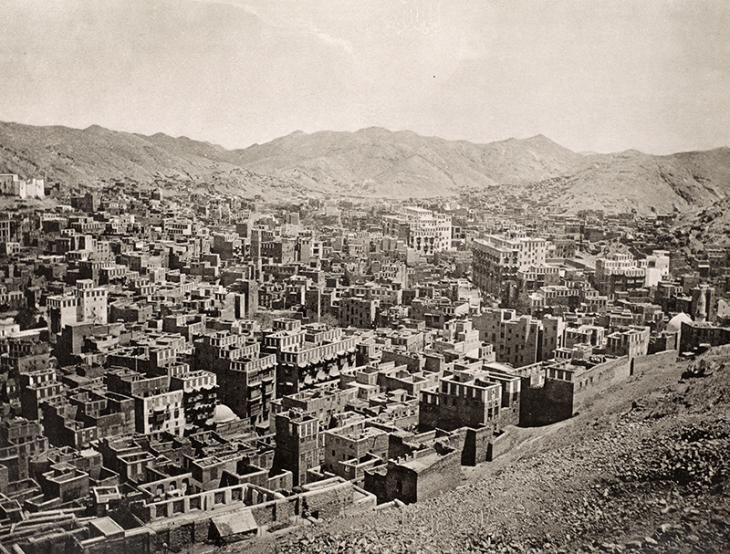
Since the 1880s, the city of Mecca has been photographed and filmed. One of the most notable photographers of the city was Al Sayyid Abd al Ghaffar. Al Ghaffar carried cumbersome equipment throughout the desert city, capturing scenes of thousands of Muslim pilgrims camped in the surrounding hills and valleys during the Hajj.
The birthplace is visible in al Ghaffar's celebrated photograph (figure ?) of the scene from the Jiyād fortress (in the left of the photograph) to the birthplace - located to the right, and marked by the author's red triangle.
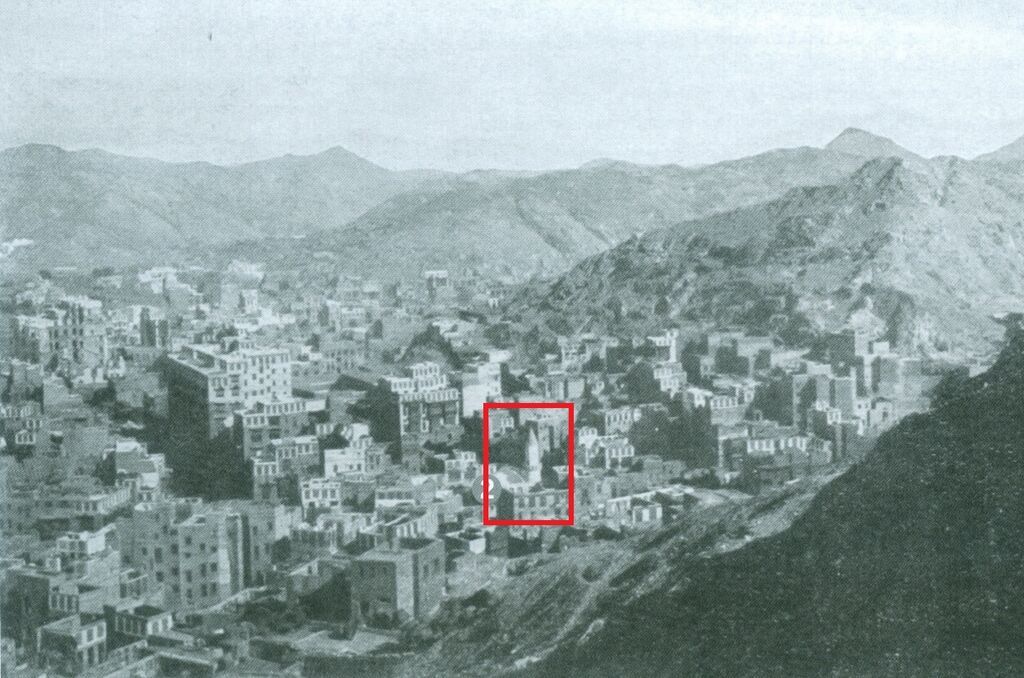
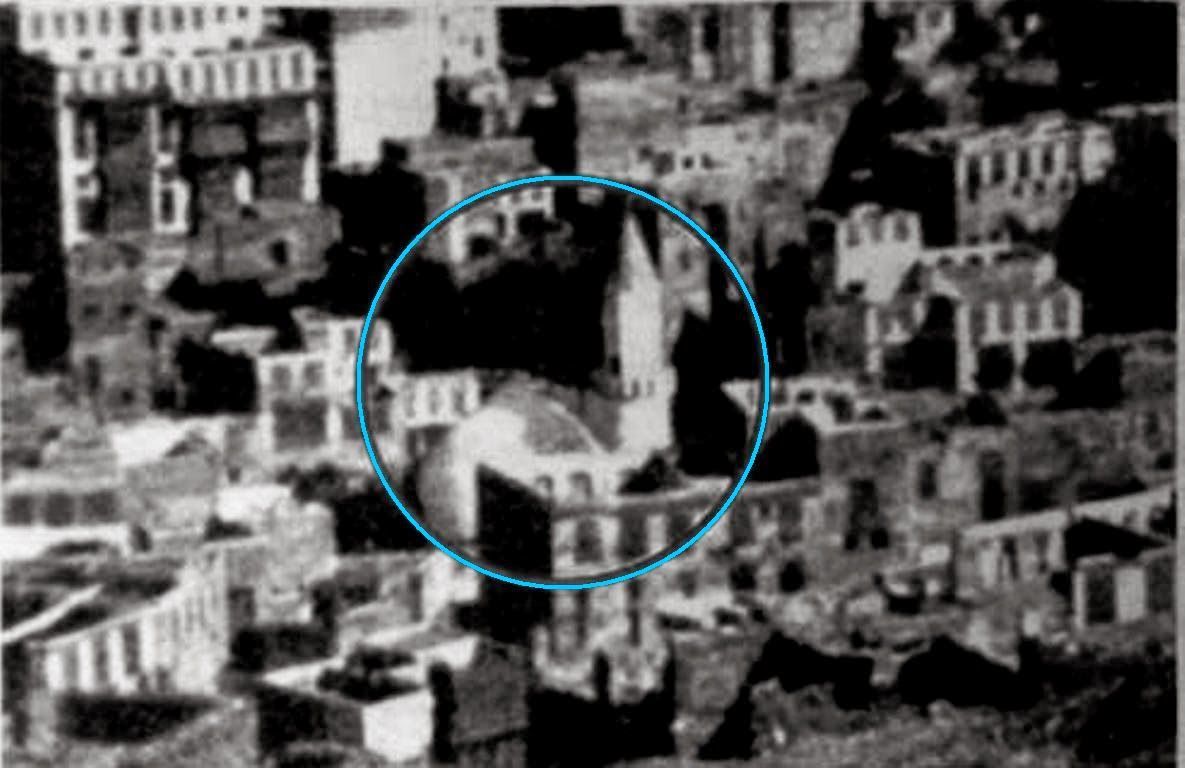
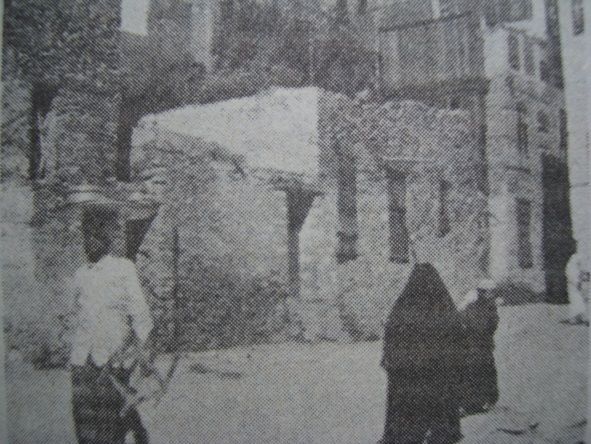
King Abdul-Aziz 1926
The armies of King Abdul-Aziz (d. 1953), the founder of the Saudi state, conquered Mecca and Medina in 1924 and 1925, respectively. Early the next year, Abdul-Aziz granted permission to the Ikhwan, a Bedouin tribal army adhering to Muhammad ibn Abd al-Wahhab‘s school of thought, to remove the domes on tombs and other religious structures in Mecca. [[[ in accordance with their doctrine.]]] However, while acceding to demands for dome eradication, Abdul-Aziz‘s awareness of broader Muslim sensibilities resulted in him prohibiting the destruction of the remaining structures of these domed buildings. fn1 Hence, while the dome above the bp house was removed, the house itself was left primarily intact.
Fn1: Habib, John S., Ibn Sa‟ud‟s Warriors of Islam: The Ikhwan of Najd and their Role in the Creation of the Sa‟udi Kingdom (Leiden, 1978), p. 115
EXTRA:
https://muhammadencyclopedia.com/article/first-demolition-and-re-construction-of-the-birthplace-of-prophet-muhammad#content-foot-5
Second Demolition of the Birthplace of Prophet Muhammad
In 1924 A.D., when Sultan Abdul Aziz ibn Abd Al-Rahman Al-Faisal ibn Saud occupied Hijaz, he demolished it again. At that time however, the mosque remained safe. Later on, in 1925 A.D., this mosque was also demolished. Ali Shabbir quotes the author of "The Journey to Haramain Sharifain" and states th######some letters deleted here#####r of "The Journey to Haramain Sharifain" came to perform pilgrimage, he found that the land was levelled and there was no trace of the Holy Prophet's birthplace at that time. 5 FT5
FT5: Ali Shabbir (1930), Tareekh Maulid Al-Nabi, Deccan Law Report, Deccan, India, Pg. 23-24.
https://muhammadencyclopedia.com/article/first-demolition-and-re-construction-of-the-birthplace-of-prophet-muhammad#content-foot-5
####
In January 1925, Wahhabis ""purified' the holy cities as they had in the early nineteenth century: by destroying places of worship deemed un-Islamic-including the shrine of Mawlid al-Nabi (birthplace of the Prophet), the house of Khadija, the Prophet's wife, and Bait Abu-Bakr" (Yamani: 10). Most of the domes over the tombs of prominent early Muslim leaders were then destroyed, "including those of the Caliph Uthman, the legist Malik ibn Anas, and four Shia imams, but the tomb of the Prophet himself was not altered. However, the dome and the minaret built at the mosque marking the birthplace of the Prophet Muhammad in Mecca were torn down. Many Muslims inside and outside the Hejaz objected to the destruction of such structures and sites" (Ochsenwald 2007: 21-2). In 1950, the grave of the Prophet's wife was destroyed. Until today, "five of the renowned 'Seven Mosques' initially built by
########
https://en.wikihaj.com/view/Mawlid_al-Nabi#Destruction_and_Construction_of_the_Library
Destruction and Construction of the Library
In the House of Sa'ud rule, the building of Mawlid al-Nabi, like many old buildings in Mecca, was destroyed in the year 1343/1924-25 under the pretext that people were seeking blessings in it.[18]
Later, because there was no grave to be visited in this place, some people tried to get permission to rebuild it. In 1370/1950-51, permission was issued to build a library in the place.
The construction cost was paid by Fatima, daughter of Yusuf al-Qattan, and her brother Shaykh 'Abbas al-Qattan (d. 1370/1950-51) supervised the construction of the building, and after his death, his sons finished the construction of the building. In this way, the Library of Makkah al-Mukarrma was built in this place.[19]
18. Bilādī, Maʿālim Makka, p. 294.
19:↑ Abū Sulaymān, Maktabat Makka al-mukarrama, p. 80.
References
- ʿAbd al-Wahhāb Ibrāhīm Abū Sulaymān. Maktabat Makka al-mukarrama qadīman wa ḥadīthan. Riyadh: Maktaba al-Malik Fahd al-Waṭanīyya, 1433AH.
- Azraqī, Muḥammad b. ʿAbd Allāh al-. Akhbār Makka wa mā jāʾa fī-hā min al-āthār. Edited by Rushdī Ṣāliḥ Mulḥis. Beirut: 1403AH.
- Batanūnī, Muḥammad Labīb al-. Al-Riḥla al-Ḥijāzīyya. Cairo: Al-Thiqāfat al-Dīnīyya, n.d.
- Bilādī, ʿĀtiq al-.Maʿālim Makka al-tārikhīyya wa al-atharīyya. Dār Makka: 1400 AH.
- Çelebi, Evliya. Al-Riḥla al-Ḥijāzīyya. Dār al-Āfāq al-ʿArabīyya, 1420 AH.
- Fāsī al-Makkī, Muḥammad b. Aḥmad al-.Shifāʾ al-gharām bi-akhbār al-balad al-ḥarām. Edited by ʿUmar ʿAbd al-Salām al-Tadmurī. Beirut: Dār al-Kitāb al-ʿArabī, 1405 AH.
- Jubayr, Muḥammad b. Aḥmad. Safarnāma-yi Ibn Jubayr. Translated by Parwīz Atābakī. Mashhad: Intishārāt-i Āstān-i Quds-i Raḍawī, 1370 Sh.
- Makkī,ʿAbd Allāh Ghāzī al-.Ifādat al-anām bi-akhbār Balad Allah al-ḥarām.
- Nāblusī, ʿAbd al-Ghanī al-. Al-Ḥaqīqa wa l-majāz fī raḥlat al-bilād al-Shām wa Misr wa al-Ḥijāz. Damascus: Dār al-Maʿrifa, 1419AH.
- Nahrawālī al-Makkī, Quṭb al-Dīn al-.Al-Iʿlām bi-aʿlām Bayt Allāh al-harām. Cairo: Maktabat al-Thiqāfat al-Dīnīyya, 1425AH.
- Sanjārī, ʿAlī b. Tāj al-Dīn al-. Manāʾiḥ al-karam. Mecca: Umm al-Qurā University, 1998.
- Ṭabarī, Muḥammad b. ʿAlī al-. Tārikh Makka, ittiḥāf fuḍalāʾ al-zaman bi-tārīkh wālī-h banī l-Ḥasan. Cairo: Dār al-Kitāb al-Jāmiʿī, 1413AH.
#####
Years later, King Abd al-Aziz ibn Saud gave the vacant land to the
Amin al-Asima at that time,
Shaykh Abbas ibn Yusuf al-Qattan, who
built upon it the library known as Maktabat Makkat al-Mukarrama.
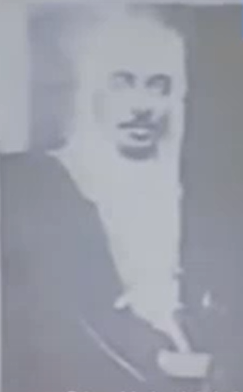
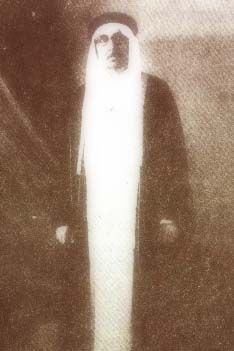
Shaykh Abbas bin Yusuf al-Kattan 1951
The state‘s ownership ended in 1951, when King Abdul-Aziz gave the bp site to Shaykh Abbas bin Yusuf al-Kattan , the former treasurer/mayor of Mecca. Kattan intended to built a public library, the Maktabah library, over the structure of the bp site to both preserve it and as a gesture to honour the Prophet saw by establishing a centre of knowledge - the seeking of which the Prophet saw was immensely passionate about.
The structure of bp house lies beneath the raised plinth of the library. The height of the library‘s foundations was increased so that its base would not interfere with the birthplace house. Large parts of the walls, foundations, and floor of the birthplace house remain intact under the library.
The contents of the famous Majidiyya Library were obtained and used to stock the Maktabah library, while other private collections of Mecca have been donated over the years. [[Coincidently, ]] Kattan began building the library just two months before his death in 1370 H.E. The library was then completed by his son Shaykh Amin fn6.and began service in 1959/ 1379.
[[[The decision by King Abdul-‘Aziz to grant the bp to Kattan, likewise also happened to take place not long/shortly before his death in 1953.]]
## ##
From:
https://makkawi.azurewebsites.net/Article/276/ rest in arabic
https://makkawi.azurewebsites.net/Article/276/
A mosque was built on the place, then it was demolished due to the large number of people seeking blessings from it. Then a building was built on the place and made into the headquarters of the Mecca Library, built by Sheikh Abbas Al-Qattan in the year 1371 AH from his own money.
sheikh Abbas Qattan wished to establish a public library in this place, and he agreed with his in-laws, the Al Kurdi family, to buy from them the library of the late Sheikh Majid Al Kurdi, known as the Al Majidiyya Library, which is one of the most valuable private libraries, and to transfer its contents to this house, to protect the place where the noble Messenger, may God’s prayers and peace be upon him, was born, from remaining exposed to neglect and to honor him by establishing a useful work for the people there.
.Sheikh Abbas Qattan faced many obstacles to achieve this great dream, but he continued his attempts tirelessly. After many years of patience and seizing suitable opportunities, he was able to obtain the approval of His Majesty the late King Abdulaziz, to allow him to build the building he wanted. As soon as he received permission from His Majesty to build the building, he quickly took the necessary measures in the year 1370 AH. He personally supervised the construction every day, striving to complete it quickly and achieve the dream he sought of seeing the public library built on the site of the birth of the Prophet, may God bless him and grant him peace. One day in Rajab 1370 AH, he went as usual to see the building with some of his friends, but he felt a sudden pain while standing at the site, as he was suddenly struck by a severe heart attack. Some of his sons and friends who were present held him and called a doctor for him. He was then taken to his home, and the next day he passed away. This building, which he had wished to build, was the happy ending to his life. His sons, after him, completed the good work that their great father had started, and they moved the Al-Majidiya Library to it, and it was handed over to the Ministry of Hajj and Endowments, and it is open to everyone.
https://makkawi.azurewebsites.net/Article/276/
https://makkawi.azurewebsites.net/Article/276/
## ## ##
https://makkawi.azurewebsites.net/Article/1257/
08/10/2016
An official at the Ministry of Islamic Affairs, Call and Guidance explained that the development of the Makkah Library, the site of the Prophet's birthplace, is subject to the needs of the ongoing expansion projects at the Grand Mosque. No official project has been proposed for development, and it has been linked to the overall project for the area. He pointed out that the ministry has restored the building several times, especially since responsibility for the building falls within their mandate. He emphasized the ministry's interest in the site, given its historical significance and its ability to preserve its character and sanctity. The Story of the Place - Out of the founder King Abdulaziz's - may God have mercy on him - interest in Islamic monuments in Mecca, he issued an order to grant the Al Qattan family the place known as the Prophet's Birthplace, in addition to the place known as the House of Lady Khadija. A legal deed was issued by the Sharia Court in Mecca on 25 Jumada al-Awwal 1370. - The legal deeds for the building stipulate that "the house shall not be rented, sold, donated or exchanged, and shall remain in its original condition." The donor (Fatima Youssef Qattan), who passed away in 1413, also stipulated that the books placed therein shall not be removed and shall not be used, now or in the future, if the building is destroyed for any purpose other than that for which it was granted. - When he was the Deputy King, King Faisal - may God have mercy on him - issued an order approving what Lady Fatima Qattan had proposed in 1369, to establish a library in the place known as the Prophet's Birthplace, may God bless him and grant him peace. - A deed was issued by the Grand Sharia Court in Makkah Al-Mukarramah, No. 140 - Fourth Volume, registered under No. 666 on Sha’ban 27, 1379. - A power of attorney deed was issued by Fatima Qattan to her nephew Abbas, and the Makkah Notary Public, No. 192, on February 23, 1371.
Source: Makkah Newspaper 1438/1/6 AH - Ashraf Al-Hussaini
##################
https://muhammadencyclopedia.com/article/first-demolition-and-re-construction-of-the-birthplace-of-prophet-muhammad#content-foot-7
Establishment of Makkah Mukarramah library on the Birthplace of the Holy Prophet
Later on, Ameen ibn Sheikh Abbas Qatan, on behalf of his aunt Fatima, daughter of Yousaf Qatan, requested the government to allow them to build a library on the location where Prophet Muhammad was born. Sheikh Abu Suleiman states [[translation]]:
At the present time, one of the examples that confirms this location with multiple sources is the Sharia validation of that honorable house by the department of Supreme Sharia Court in Makkah, which is recorded in the document No.140, in 4th volume, on 25th Jumada-al-Thani, 1373 A.H. (1st February, 1954). 7 [[FT7]] The chief justice of that time, Sheikh Abdullah ibn Umar ibn Dahish specified the birthplace of Holy Prophet in it, and then verified the documents by the assembly of Qazat. (Dr. Abdul Wahab transmitted that documents as),
“I am Abdullah ibn Umar ibn Dahish, the chief justice of the Supreme Sharia Court, and I have Document No. 192 which is released by the Court of Makkah on 23/02/1952 A.D. (27th Jumada Al-Awwal, 1371 A.H.), as a lawyer, Ameen ibn Sheikh Abbas Qatan appeared on behalf of his aunt Fatima, daughter of Yousaf Qatan, he summarized: My mentioned client has submitted a request to the government that she should be allowed to set up a library on the well-known birthplace of the Prophet Muhammad in the street Souq Al-Layl, She’b Ali, the place which does not require any confirmation. After the issuance of the legal proceedings, the government issued a permit on application in Documents No. 23/525 on 14/4/1951 A.D. (7th Rajab, 1370 A.H.), because it was a good deed. After the construction of the building, there would be registration in the court. The library will be common and dedicated to all Muslims of the world with all its contents. The mentioned decree has been permitted by the king's deputy, dated 11/05/1951 A.D. (5th Shaban, 1370 A.H.) as Document No. 3068 in the Amanaat institution of the capital. A copy of which has been sent to the Supreme Court. In order to be dedicated to it, I have set certain conditions, including that the mentioned house (birthplace of the Holy Prophet ) will not be rented or sold, nor bequeathed or changed, and it will remain in its original condition. Likewise, the books contained in it will not be removed. It is also conditioned that if the building becomes dilapidated in the present or future, it will not be used for any other purposes other than its (primary) purpose, neither by its heritage nor by anyone else. Thus, according to the rules, it is proved to me that Fatima ibn Yosuf Qatan has constructed the mentioned building by her own money. Therefore, I have allowed and signed the dedicated building with the conditions mentioned above, and ordered for its written documentations on 25 Jumada al- Thani, 1373 A.H., which is honorable”.
Commenting on this, Dr. Abdul Wahab says:
Firstly, these documents prove the authenticity of the location of the sacred (birth) place, as the chief justice, Sheikh Abdul Allah ibn Dahish, also identified it and described its attributes. He said, this place is well known as birthplace of Prophet in Souq Al-Layl, in She’b Ali because of its distinction.
Secondly, King Abdul Aziz took an auspicious step by establishing a library on this sacred place after consulting with the religious scholars (Ulema), and history will remember his name for it.
Thirdly, the court’s decision was supported by King’s deputy, who delivered the Court‘s decision to Amanaat institution located in the capital.
Fourthly, this true text is accepted by the rightful ruler, which proves the place (to be the birth place of Prophet Muhammad ) as it was already famous for it and does not need to be defined and attributed any more. Thus, this text proves the successive narration of the birthplace of the Holy Prophet for generations. Until the last quarter of 14th century, many sacred places remained in their original condition before the development and expansion of Haram Sharif. The artefacts of Makkah, which remained in their original condition for centuries, had been seen by middle generations of Makkah and the Islamic world, which were present before 1375 A.H. They saw the vestiges of civilization and religious customs which the Makki historians used to mention in the early Islamic centuries. Likewise, it is proved by the narration of historical events and by the physical evidence present at the location, that Library of Makkah Mukarrama is located on the (true) birthplace of the Prophet Muhammad. FT6
FT6: Abu Sulaiman Abd Al-Wahab Ibrahim (2012), Maktabah Makkah Al-Mukarramah Qadeeman wa Hadithan, Maktabah Al-Malik Fahad Al-Wataniyah, Riyadh, Saudi Arabia, Pg. 52-55۔
FT7: The date mentioned in the translation is according to the author of the book. The correct date, as per the digital date calculators is 28th February, 1954 or 1st March 1954.
FT7: The date mentioned in the translation is according to the author of the book. The correct date, as per the digital date calculators is 28th February, 1954 or 1st March 1954.
After taking the permission from the government, Sheikh Abbas Qatan started the construction work at the Mawlid’s site at a rapid pace, so that this blessed site could be preserved. He supervised the work on a daily basis so that it could be completed as soon as possible. However, he could not live to see this library in its completed form. The work was then completed by his sons, who also moved all the books from the Majidia Library to the Library of Makkah Al-Mukarramah and handed over the finished library to the ministry of Endowments. 8 FT8
FT8: Abu Sulaiman Abd Al-Wahab Ibrahim (2012), Maktabah Makkah Al-Mukarramah Qadeeman wa Hadithan, Maktabah Al-Malik Fahad Al-Wataniyah, Riyadh, Saudi Arabia, Pg. 88-89.
Dr. Nasir ibn Ali 9 [FT9] and Shaikh Muhammad Tahir Al-Kurdi 10 [FT10] also acknowledged the services of Shaikh Qatan for the Mawlid of Prophet Muhammad .
FT9: Nasir ibn Ali Al-Harithi (2009), Al-Aathar Al-Islamiyah fe Makkah Al-Mukarramah, Maktabah Al-Malik Fahad Al-Wataniyah, Riyadh, Saudi Arabia, Pg. 358.
FT10: Shaikh Muhammad Tahir Al-Kurdi Al-Makki (2000), Al-Tareekh Al-Qaweem li Makkah wa Baitellah Al-Kareem, Dar Khadr lil Taba’at wal Nashr wal Tawzi, Beirut, Lebanon, Vol. 1, Pg. 286-287.
https://muhammadencyclopedia.com/article/first-demolition-and-re-construction-of-the-birthplace-of-prophet-muhammad#content-foot-7
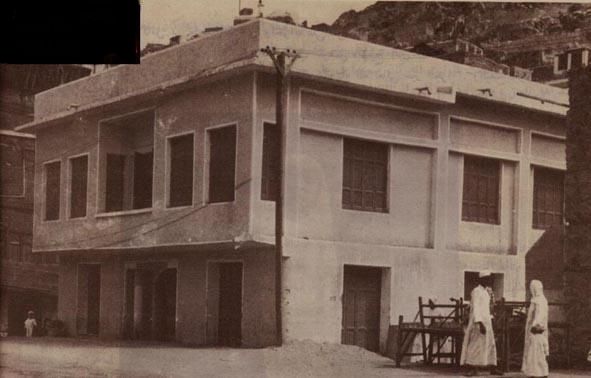
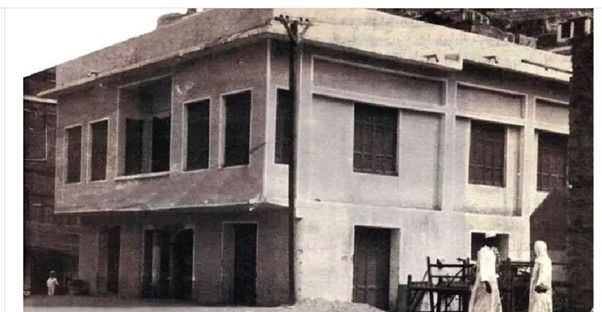
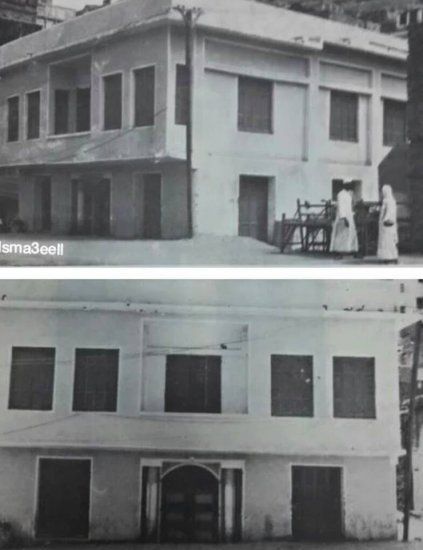
m. Above photos from 1950s,
Ministry of Hajj and Endowments c.????
The bp site/library was taken back into state control c.????, and now operates under the patronage of the Ministry of Hajj and Endowments (MHE). The MHE has refurbished parts of the library and carried out other essential works such as manuscript binding. The current status of the library is described as ‗Public library (governmental)‘, [[and the library is open throughout the week except Thursdays and Fridays.]]fn1
The exact spot where the birth of the Prophet saw took place is located on the north-east side of the library site, and is distinguished by a covering of marble which has been fixed over the area . Access to this part of the site is prohibited to the public.
Fn1: www.al-furqan.com Telephone: 02/5741812
Kaleeurrahmanqaathiri@gmail.com--Ask for photos
#############
https://www.aleqt.com/2017/09/22/article_1255506.html
The Makkah Library was initially administratively linked to the General Directorate of Press, Broadcasting and Publishing, then transferred to the Ministry of Hajj and Endowments, then to the Ministry of Islamic Affairs, Endowments, Call and Guidance, and finally to the General Authority for Endowments.
##################
Several entities have assumed supervision of the Makkah Library. From 1370-1380 AH (1953-1963 AD), the library was administratively affiliated with the Ministry of Information, and Sheikh Muhammad Qasim Hariri assumed its management during this period.
From 1380-1414 AH (1963-1993 AD), it became administratively affiliated with the Ministry of Hajj and Endowments, and Sheikh Muhammad Rashid Faris assumed its management. Sheikh Abdulmalik bin Abdulqader Al-Tarabulsi then assumed its management from 1386 AH (1967 AD) until today.
Since 1414 AH (1993 AD), a royal decree was issued establishing the Ministry of Islamic Affairs, Endowments, Call and Guidance, under whose direct management the Makkah Library has been directly affiliated.
#################
Many entities have taken on the task of supervising the Makkah Library. In the period from 1370 to 1380 AH, the library was administratively affiliated with the Saudi Ministry of Information, and Sheikh Muhammad Qasim Hariri took over its management during this period . After that, from 1380 to 1414 AH, it became administratively affiliated with the Ministry of Hajj and Endowments (currently the Ministry of Hajj and Umrah). Sheikh Muhammad Rashid Faris took over its management, then Sheikh Abdul Malik bin Abdul Qadir Al-Tarabulsi, who took over its management from 1386 AH (1967 AD) until now.
Since 1414 AH, a royal decree was issued establishing the Ministry of Islamic Affairs, Endowments, Call and Guidance , under whose administration the Makkah Library has been directly affiliated.
####
Many parties succeeded in assuming the task of supervising the Library of Mecca. During the period from the year (1370 - 1380 AH) the library was administratively affiliated with the Saudi Ministry of Information, and its management was assumed during this period by Sheikh Muhammad Qasim Hariri, and after that in the year (1380 - 1414 AH) it became administratively affiliated with the Ministry of Hajj and Endowments, and Sheikh Muhammad Rashid Fares took over its management, then Sheikh Abdul Malik bin Abdul Qadir. Al-Trabelsi, who took over its management from 1386 AH - 1967 AD until now.



Originally turned into a library, it now lies under a rundown building which was built 70 years ago as a compromise after Wahhabi clerics called for it to be demolished
Historian and researcher Abdul Wahhab Abu Sulaiman presented the Sharia ruling on the proposed development of the birthplace site and preserving historical sites in and around Mecca, arguing that they should be protected under Islamic law.
All these sites date from the 6th century, except for Jabal Qubais.
--
https://islam4u.pro/blog/the-lion-of-allah-and-the-lion-of-his-messenger-hamza-ibn-abd-al-muttalib/
This title was given to him by one who does not speak out of desire, as his speech is not influenced by pleasure or anger, nor by love or hatred. Kinship has no role in taking positions. How could it be when he is the Seal of the Prophets, peace be upon him and his family? He takes the appropriate stance for each person and their actions.
--
https://hasansagaf.wordpress.com/2010/06/20/tempat-lahir-nabi/
https://hasansagaf.wordpress.com/2010/06/20/tempat-lahir-nabi/
What is meant here does not mean that we worship that place or that it does not mean that he has incarnated in that place, but what is meant is to remember his service in struggle and remind him of the height and nobility of his dignity in the sight of Allah.
"Library of Mecca al-Mukarramah". And Muslims from abroad always crowd the place. As an expression of longing for the Prophet of the end times, the leader who will intercede until the Day of Judgment.
The condition of the birthplace of the Prophet SAW, which measures about 10X18 meters,
This place was once known as the valley of Abu Thalib. When the Prophet migrated to Medina, this house was inhabited by Aqil bin Abi Thalib who was then inhabited by his descendants.
In 1370/1950, the birthplace of the Prophet was made a library waqf at the request of Sheikh Abbas Al-Qattan who was the governor of the city of Mecca at that time. His request was approved by the Saudi government on the condition that this waqf could not be sold or rented, or could not be given as a gift to anyone, or could not be exchanged or lent to anyone.
https://hasansagaf.wordpress.com/2010/06/13/19/
Places In Mecca That Testify
Angawi, who founded the Haj Research Centre in 1975 to study and preserve Mecca and Medina's rich history, claims to have identified a home of the Prophet Mohammed. But he is reluctant to publicise its location fearing it would be demolished like Dar al Arqam -- the first school in Islam where the prophet taught.
https://en.wikihaj.com/view/Mawlid_al-Nabi#Destruction_and_Construction_of_the_Library
Renovations
The building of Mawlid al-Nabi was the attention of princes and kings and was renovated many times. The list of these renovations is as follows:
- 576/1180-81, By al-Naser, the 'Abbasid Caliph;
- 666/1267-68, King al-Muzaffar, the ruler of Yemen;
- 740/1339-40, King al-Mujahid, the ruler of Yemen;
- 758/1357, Amir Shaykhun, a nobleman from Egypt;
- 766/1364-65, King Sha'ban, King of Egypt;
- 801/1398-99, King al-Zahir Barquq, King of Egypt;[11]
In the Ottoman Era
- In 935/1528-29, King Sulayman;
- In 1009/1600-1, by the order of King Muhammad under the supervision of Ghadanfar Agha[12] In this reconstruction, a large dome and a minaret were built for this building, endowments were assigned for it, and a mu'azzin, a servant, and an imam for congregational prayer were assigned for the mosque by the Ottoman government.[13]
- In 1230/1850, Muhammad 'Ali Pasha of Egypt by the order of King Muhammad Khan.
- The last repair is said to have been in the time of 'Abd al-Majid Khan.[14]
Notes
- ↑ Fasi al-Makki, Shifa' al-gharam, vol. 1, p. 270.
- ↑ Azraqī, Akhbār Makka, vol. 2, p. 198.
- ↑ Fakihi, Akhbar Makka fi qadim al-dahr wa haithih, vol. 4, p. 5.
- ↑ Jubayr, Safarnāma-yi Ibn Jubayr, p. 82, 125.
- ↑ Jubayr, Safarnāma-yi Ibn Jubayr, p. 154.
- ↑ Jubayr, Safarnāma-yi Ibn Jubayr, p. 126-127.
- ↑ Fasi, Shifa' al-gharam, vol. 1, p. 268.
- ↑ Çelebi, al-Riḥla al-Ḥijāzīyya, pp. 255-256
- ↑ Safarnam-iy Mulla Ibrahim Kaziruni, p. 366.
- ↑ Batanuni , Safarnam-iy hijaz, p. 146.
- ↑ Fasi, Shifa' al-gharam, vol. 1, p. 270.
- ↑ Sanjārī, Manāʾiḥ al-karam, vol. 3, p. 506.
- ↑ Ṭabarī, Tārikh Makka, vol. 2, p. 15.
- ↑ Makkī, Ifādat al-anām, vol. 2, p. 71.
- ↑ Ibn Jubayr, 'Safarnama Ibn Jubayr, p. 154.
- ↑ Nahrawānī, al-Iʿlām bi-aʿlām Bayt Allāh al-harām, p. 422.
- ↑ Nāblusī, Al-Ḥaqīqa wa l-majāz, vol. 3, p. 354-355.
- ↑ Bilādī, Maʿālim Makka, p. 294.
- ↑ Abū Sulaymān, Maktabat Makka al-mukarrama, p. 80.
References
References
- ʿAbd al-Wahhāb Ibrāhīm Abū Sulaymān. Maktabat Makka al-mukarrama qadīman wa ḥadīthan. Riyadh: Maktaba al-Malik Fahd al-Waṭanīyya, 1433AH.
- Azraqī, Muḥammad b. ʿAbd Allāh al-. Akhbār Makka wa mā jāʾa fī-hā min al-āthār. Edited by Rushdī Ṣāliḥ Mulḥis. Beirut: 1403AH.
- Batanūnī, Muḥammad Labīb al-. Al-Riḥla al-Ḥijāzīyya. Cairo: Al-Thiqāfat al-Dīnīyya, n.d.
- Bilādī, ʿĀtiq al-.Maʿālim Makka al-tārikhīyya wa al-atharīyya. Dār Makka: 1400 AH.
- Çelebi, Evliya. Al-Riḥla al-Ḥijāzīyya. Dār al-Āfāq al-ʿArabīyya, 1420 AH.
- Fāsī al-Makkī, Muḥammad b. Aḥmad al-.Shifāʾ al-gharām bi-akhbār al-balad al-ḥarām. Edited by ʿUmar ʿAbd al-Salām al-Tadmurī. Beirut: Dār al-Kitāb al-ʿArabī, 1405 AH.
- Jubayr, Muḥammad b. Aḥmad. Safarnāma-yi Ibn Jubayr. Translated by Parwīz Atābakī. Mashhad: Intishārāt-i Āstān-i Quds-i Raḍawī, 1370 Sh.
- Makkī,ʿAbd Allāh Ghāzī al-.Ifādat al-anām bi-akhbār Balad Allah al-ḥarām.
- Nāblusī, ʿAbd al-Ghanī al-. Al-Ḥaqīqa wa l-majāz fī raḥlat al-bilād al-Shām wa Misr wa al-Ḥijāz. Damascus: Dār al-Maʿrifa, 1419AH.
- Nahrawālī al-Makkī, Quṭb al-Dīn al-.Al-Iʿlām bi-aʿlām Bayt Allāh al-harām. Cairo: Maktabat al-Thiqāfat al-Dīnīyya, 1425AH.
- Sanjārī, ʿAlī b. Tāj al-Dīn al-. Manāʾiḥ al-karam. Mecca: Umm al-Qurā University, 1998.
- Ṭabarī, Muḥammad b. ʿAlī al-. Tārikh Makka, ittiḥāf fuḍalāʾ al-zaman bi-tārīkh wālī-h banī l-Ḥasan. Cairo: Dār al-Kitāb al-Jāmiʿī, 1413AH.
https://digitallibrary.al-furqan.com/world_library_details/id/63600
Date of establishment:1379/1959
Status:Institutional
Status Details:Public library (governmental)
not sure in whose ownership the BP was after Aquil, but it seems it was under the control of the state authorities until the present day.
